Mid-Infrared Optoelectronic Devices Based on Two-Dimensional Materials beyond Graphene: Status and Trends
Abstract
:1. Introduction
2. Materials and Methods 2D Material Candidates for MIR Applications
2.1. BP and Related Materials
2.2. TMDCs
2.3. Perovskite
2.4. GDY
2.5. Other Candidates
3. Light Emission Devices
3.1. Spontaneous Emission
| 2D Materials | Bandgap (eV) | The Spectral Range of Operation (μm) | Ref. |
|---|---|---|---|
| BP | 0.3~1.5 | 0.83~4.13 | [185] |
| b-AsP | 0.15 | 8.27 | [94] |
| b-PC | 0.59 | 2.10 | [95] |
| ReSe2 | 1.1~1.58 | 0.78~1.12 | [110] |
| PdSe2 | 1.3 | 0.95 | [121] |
| PtSe2 | 0.3 | 4.13 | [116] |
| GDY | 0.46~1.10 | 1.12~2.69 | [141] |
| 2D Te | 0.35~1.265 | 0.98~3.54 | [154] |
| Bi2Te3 | 0.21 | 5.90 | [161] |
| Sb2Te3 | 0.45 | 2.75 | [164] |
3.2. Laser
4. Modulator
4.1. All Optical Approach
4.2. Electro-Optic Approach
4.3. Other Approaches
5. Photodetectors
5.1. Waveguide-Based Photodetectors
5.2. Schottky Photodetector and Phototransistor
5.3. Photoelectrochemical Photodetector
5.4. MIR Imaging
6. Results Conclusions and Outlook
- In terms of LEDs, compared to commercially available LEDs, the external quantum efficiency and operation stability of 2D materials-based LEDs are still too low. To satisfy the demand of practical applications, the external quantum efficiency and operation stability need to be significantly improved. Furthermore, the emitting wavelength needs to be further extended, which is far from the practical application. For driven mode, more attention should be concentrated on the electrically driven mode. Thus, it is of great significance to develop novel 2D materials-based LEDs with various configurations in the future.
- Regarding single-photon emitters based on 2D materials, they are thought to be originated from the defects. However, the underlying physical mechanism, excitation processes, and atomic structure are still under debate. Meanwhile, the emitting wavelength needs to be extended into the deep MIR region.
- The lasing threshold is relatively low at a lower temperature, however, for room temperature lasing, the threshold needs to be significantly suppressed.
- For modulator applications, the irradiation damage threshold of 2D materials needs to be improved. In addition, the long term operation stability needs to be enhanced as well, which plays a determining role for practical applications. Moreover, only a few kinds of 2D material can be utilized for electro-optic modulators. Further improving the architecture of optical modulators and exploring novel 2D materials may provide an alternative means to overcome these challenges.
- In terms of MIR photodetectors, since the weaker optical absorption of the MIR light, the photo responsivity, carrier mobility, and response speed are much lower and slower than that of visible and NIR photodetectors. Combined with other materials with higher MIR light absorption coefficient to establish heterojunction may provide an effective way to solve these problems.
- For MIR imaging applications, the recent devices mainly adopt a point photodetector, which is far from the practical application. MIR imaging devices based on large scale 2D material arrays should be developed.
Author Contributions
Funding
Data Availability Statement
Conflicts of Interest
References
- Novoselov, K.S.; Geim, A.K.; Morozov, S.V.; Jiang, D.; Zhang, Y.; Dubonos, S.V.; Grigorieva, I.V.; Firsov, A.A. Electric field effect in atomically thin carbon films. Science 2004, 306, 666. [Google Scholar] [CrossRef] [PubMed] [Green Version]
- Bonaccorso, F.; Sun, Z.; Ferrari, T.H.A.C. Graphene photonics and optoelectronics. Nat. Photonics 2010, 4, 611–622. [Google Scholar] [CrossRef] [Green Version]
- Ramasubramaniam, A.; Naveh, D.; Towe, E. Tunable band gaps in bilayer transition-metal dichalcogenides. Phys. Rev. B 2011, 84, 205325. [Google Scholar] [CrossRef]
- Wang, Q.H.; Kalantar-Zadeh, K.; Kis, A.; Coleman, J.N.; Strano, M.S. Electronics and optoelectronics of two-dimensional transition metal dichalcogenides. Nat. Nanotechnol. 2012, 7, 699. [Google Scholar] [CrossRef] [PubMed]
- Tongay, S.; Sahin, H.; Ko, C.; Luce, A.; Fan, W.; Liu, K.; Zhou, J.; Huang, Y.S.; Ho, C.H.; Yan, J.; et al. Monolayer behaviour in bulk ReS2 due to electronic and vibrational decoupling. Nat. Commun. 2014, 5, 3252. [Google Scholar] [CrossRef] [PubMed] [Green Version]
- Miro, P.; Ghorbani-Asl, M.; Heine, T. Two dimensional materials beyond MoS2: Noble-transition-metal dichalcogenides. Angew. Chem. Int. Ed. 2014, 53, 3015–3018. [Google Scholar] [CrossRef]
- Zhang, W.; Chiu, M.H.; Chen, C.H.; Chen, W.; Li, L.J.; Wee, A.T. Role of metal contacts in high-performance phototransistors based on WSe2 monolayers. ACS Nano 2014, 8, 8653–8661. [Google Scholar] [CrossRef] [Green Version]
- Li, L.; Yu, Y.; Ye, G.J.; Ge, Q.; Ou, X.; Wu, H.; Feng, D.; Chen, X.H.; Zhang, Y. Black phosphorus field-effect transistors. Nat. Nanotechnol. 2014, 9, 372–377. [Google Scholar] [CrossRef] [Green Version]
- Buscema, M.; Groenendijk, D.J.; Blanter, S.I.; Steele, G.A.; van der Zant, H.S.; Castellanos-Gomez, A. Fast and broadband photoresponse of few-layer black phosphorus field-effect transistors. Nano Lett. 2014, 14, 3347–3352. [Google Scholar] [CrossRef] [Green Version]
- Engel, M.; Steiner, M.; Avouris, P. Black phosphorus photodetector for multispectral, high-resolution imaging. Nano Lett. 2014, 14, 6414–6417. [Google Scholar] [CrossRef]
- Zhang, Q.; Ha, S.T.; Liu, X.; Sum, T.C.; Xiong, Q. Room-temperature near-infrared high-q perovskite whispering-gallery planar nanolasers. Nano Lett. 2014, 14, 5995–6001. [Google Scholar] [CrossRef] [PubMed]
- Kojima, A.; Teshima, K.; Shirai, Y.; Miyasaka, T. Organometal halide perovskites as visible-light sensitizers for photovoltaic cells. J. Am. Chem. Soc. 2009, 131, 6050–6051. [Google Scholar] [CrossRef] [PubMed]
- Zong, M.-Y.; Zu, Y.-Q.; Guo, J.; Zhang, Z. Broadband nonlinear optical response of graphdiyne for mid-infrared solid-state lasers. Sci. China Phys. Mech. Astron. 2021, 64, 294214. [Google Scholar] [CrossRef]
- Li, X.J. Graphdiyne: A promising nonlinear optical material modulated by tetrahedral alkali-metal nitrides. J. Mol. Liq. 2019, 277, 641–645. [Google Scholar] [CrossRef]
- Li, J.F.; Wang, C.; Zhang, B.; Wang, Z.H.; Yu, W.J. Artificial Carbon Graphdiyne: Status and Challenges in Nonlinear Photonic and Optoelectronic Applications. ACS Appl. Mater. Interfaces 2020, 12, 49281–49296. [Google Scholar] [CrossRef]
- Mueller, T.; Xia, F.; Avouris, P. Graphene photodetectors for high-speed optical communications. Nat. Photonics 2010, 4, 297–301. [Google Scholar] [CrossRef] [Green Version]
- Zheng, Z.; Zhang, T.; Yao, J.; Zhang, Y.; Xu, J.; Yang, G. Flexible, transparent and ultra-broadband photodetector based on large-area WSe2 film for wearable devices. Nanotechnology 2016, 27, 225501. [Google Scholar] [CrossRef]
- Fang, H.; Hu, W.; Wang, P.; Guo, N.; Luo, W.; Zheng, D.; Gong, F.; Luo, M.; Tian, H.; Zhang, X.; et al. Visible light-assisted high-performance mid-infrared photodetectors based on single InAs nanowire. Nano Lett. 2016, 16, 6416–6424. [Google Scholar] [CrossRef]
- Song, H.S.; Li, S.L.; Gao, L.; Xu, Y.; Ueno, K.; Tang, J.; Cheng, Y.B.; Tsukagoshi, K. High-performance top-gated monolayer SnS2 field-effect transistors and their integrated logic circuits. Nanoscale 2013, 5, 9666–9670. [Google Scholar] [CrossRef]
- Lim, D.; Kannan, E.S.; Lee, I.; Rathi, S.; Li, L.; Lee, Y.; Khan, M.A.; Kang, M.; Park, J.; Kim, G.H. High performance MoS2-based field-effect transistor enabled by hydrazine doping. Nanotechnology 2016, 27, 225201. [Google Scholar] [CrossRef]
- Zhao, Y.; Qiao, J.; Yu, Z.; Yu, P.; Xu, K.; Lau, S.P.; Zhou, W.; Liu, Z.; Wang, X.; Ji, W.; et al. High-electron-mobility and air-stable 2D layered PtSe2 FETs. Adv. Mater. 2017, 29, 1604230. [Google Scholar] [CrossRef] [PubMed]
- Tamalampudi, S.R.; Lu, Y.Y.; Kumar, U.R.; Sankar, R.; Liao, C.D.; Moorthy, B.K.; Cheng, C.H.; Chou, F.C.; Chen, Y.T. High performance and bendable few-layered InSe photodetectors with broad spectral response. Nano Lett. 2014, 14, 2800–2806. [Google Scholar] [CrossRef] [PubMed]
- Yao, J.; Zheng, Z.; Yan, G. All-Layered 2D Optoelectronics: A High-Performance UV–vis–NIR Broadband SnSe Photodetector with Bi2Te3 Topological Insulator Electrodes. Adv. Funct. Mater. 2017, 27, 1701823. [Google Scholar] [CrossRef]
- Xia, F.; Wang, H.; Jia, Y. Rediscovering black phosphorus as an anisotropic layered material for optoelectronics and electronics. Nat. Commun. 2014, 5, 4458. [Google Scholar] [CrossRef] [PubMed] [Green Version]
- Yin, Y.; Li, S.; Ren, J.; Du, Y.; Farrell, G.; Brambilla, G.; Wang, P.F. All-optical modulation in Black Phosphorus functionalized microfibre coil resonator. Meas. Sci. Technol. 2021, 32, 015202. [Google Scholar] [CrossRef]
- Wang, Z.W.; Zhao, R.W.; He, J.L.; Zhang, B.T.; Nie, J.S. Multi-layered black phosphorus as saturable absorber for pulsed Cr:ZnSe laser at 2.4 μm. Opt. Express 2016, 24, 1598–1603. [Google Scholar] [CrossRef] [PubMed]
- Her, Y.C.; Huang, S.L. Growth mechanism of Te nanotubes by a direct vapor phase process and their room-temperature CO and NO2 sensing properties. Nanotechnology 2013, 24, 215603. [Google Scholar] [CrossRef] [PubMed] [Green Version]
- Bo, Z.; Cui, T. An ultrasensitive and low-cost graphene sensor based on layer-by-layer nano self-assembly. Appl. Phys. Lett. 2011, 98, 243. [Google Scholar]
- Li, W.; Geng, X.; Guo, Y.; Rong, J.; Gong, Y.; Wu, L.; Zhang, X.; Li, P.; Xu, J.; Cheng, G. Reduced graphene oxide electrically contacted graphene sensor for highly sensitive nitric oxide detection. ACS Nano 2011, 5, 6955–6961. [Google Scholar] [CrossRef]
- Liu, G.; Ahsan, S.; Khitun, A.G.; Lake, R.K.; Balandin, A.A. Graphene-based non-Boolean logic circuits. J. Appl. Phys. 2013, 114, 154310. [Google Scholar] [CrossRef] [Green Version]
- Gao, G.; Wan, B.; Liu, X.; Sun, Q.; Yang, X.; Wang, L.; Pan, C.; Wang, Z.L. Tunable Tribotronic Dual-Gate Logic Devices Based on 2D MoS2 and Black Phosphorus. Adv. Mater. 2018, 30, 1705088. [Google Scholar] [CrossRef] [PubMed]
- Khan, A.F.; Randviir, E.P.; Brownson, D.A.; Ji, X.; Smith, G.C.; Banks, C.E. 2D hexagonal boron nitride (2D-hBN) explored as a potential electrocatalyst for the oxygen reduction reaction. Electroanalysis 2017, 29, 622–634. [Google Scholar] [CrossRef] [Green Version]
- Khan, K.; Tareen, A.K.; Aslam, M.; Khan, S.A.; Khan, Q.; Khan, Q.U.; Saeed, M.; Saleemi, A.S.; Kiani, M.; Ouyang, Z.; et al. Fe-doped mayenite electride composite with 2D reduced Graphene Oxide: As a non-platinum based, highly durable electrocatalyst for Oxygen Reduction Reaction. Sci. Rep. 2019, 9, 19809. [Google Scholar] [CrossRef] [PubMed] [Green Version]
- Khan, K.; Tareen, A.K.; Aslam, M.; Khan, M.F.; Shi, Z.; Ma, C.; Shams, S.S.; Khatoon, R.; Mahmood, N.; Zhang, H.; et al. Synthesis, properties and novel electrocatalytic applications of the 2D-borophene Xenes. Prog. Solid State Chem. 2020, 59, 100283. [Google Scholar] [CrossRef]
- Lu, S.B.; Miao, L.L.; Guo, Z.N.; Qi, X.; Zhao, C.J.; Zhang, H.; Wen, S.C.; Tang, D.Y.; Fan, D.Y. Broadband nonlinear optical response in multi-layer black phosphorus: An emerging infrared and mid-infrared optical material. Opt. Express 2015, 23, 11183–11194. [Google Scholar] [CrossRef]
- Guo, Q.; Pospischil, A.; Bhuiyan, M.; Jiang, H.; Tian, H.; Farmer, D.; Deng, B.; Li, C.; Han, S.J.; Wang, H.; et al. Black phosphorus mid-infrared photodetectors with high gain. Nano Lett. 2016, 16, 4648–4655. [Google Scholar] [CrossRef] [Green Version]
- Li, P.; Zhang, D.; Wu, J.; Cao, Y.; Wu, Z. Flexible integrated black phosphorus sensor arrays for high performance ion sensing. Sens. Actuators B Chem. 2018, 273, 358–364. [Google Scholar] [CrossRef]
- Liu, C.; Lin, W.; Chen, X.; Zhou, J. Top-Gated Black Phosphorus Phototransistor for Sensitive Broadband Detection. Nanoscale 2018, 10, 5852–5858. [Google Scholar] [CrossRef]
- Dugu, S.; Pavunny, S.P.; Limbu, T.B.; Weiner, B.R.; Morell, G.; Katiyar, R.S. A graphene integrated highly transparent resistive switching memory device. APL Mater. 2018, 6, 058503. [Google Scholar] [CrossRef]
- Zhao, C.; Liang, Z.; Su, M.; Liu, P.; Mai, W.; Xie, W. Self-powered, high-speed and visible–near infrared response of MoO3–x/n-Si heterojunction photodetector with enhanced performance by interfacial engineering. ACS Appl. Mater. Interfaces 2015, 7, 25981–25990. [Google Scholar] [CrossRef]
- Xiang, H.; Cheng, J.; Ma, X.; Zhou, X.; Chruma, J.J. Near-infrared phosphorescence: Materials and applications. Chem. Soc. Rev. 2013, 42, 6128–6185. [Google Scholar] [CrossRef] [PubMed]
- Ly, K.T.; Chen-Cheng, R.-W.; Lin, H.-W.; Shiau, Y.-J.; Liu, S.-H.; Chou, P.-T.; Tsao, C.-S.; Huang, Y.-C.; Chi, Y. Near-infrared organic light-emitting diodes with very high external quantum efficiency and radiance. Nat. Photonics 2017, 11, 63–68. [Google Scholar]
- Zhou, Z.; Dong, M.; Xie, X.; Gao, Z. Fusion of infrared and visible images for night-vision context enhancement. Appl. Opt. 2016, 55, 6480–6490. [Google Scholar] [CrossRef]
- Adomeit, U.; Krieg, J. Shortwave infrared for night vision applications at Fraunhofer IOSB. In Proceedings of the Optics in Atmospheric Propagation and Adaptive Systems XX, Warsaw, Poland, 13–14 September 2017. [Google Scholar]
- Chen, Y.F.; Sang, N.; Dan, Z.P. Fusion of infrared and visible images based on saliency scale-space in frequency domain. In Proceedings of the MIPPR 2015: Pattern Recognition and Computer Vision, Enshi, China, 31 October–1 November 2015; International Society for Optics and Photonics: Bellingham, WA, USA, 2015. [Google Scholar]
- Song, E.; Jiang, X.; Zhou, Y.; Lin, Z.; Ye, S.; Xia, Z.; Zhang, Q. Heavy Mn2+ doped MgAl2O4 phosphor for high-efficient near-infrared light-emitting diode and the night-vision application. Adv. Opt. Mater. 2019, 7, 1901105. [Google Scholar] [CrossRef]
- Ashiba, H.I. Cepstrum adaptive plateau histogram for dark IR night vision images enhancement. Multimed. Tools Appl. 2020, 79, 2543–2554. [Google Scholar] [CrossRef]
- Kahn, J.M.; Barry, J.R. Wireless infrared communications. Proc. IEEE 1997, 85, 265–298. [Google Scholar] [CrossRef] [Green Version]
- Konstantatos, G.; Badioli, M.; Gaudreau, L.; Osmond, J.; Bernechea, M.; de Arquer, F.P.G.; Gatti, F.; Koppens, F.H.L. Hybrid graphene–quantum dot phototransistors with ultrahigh gain. Nat. Nanotechnol. 2012, 7, 363–368. [Google Scholar] [CrossRef]
- Tan, Z.-K.; Moghaddam, R.S.; Lai, M.L.; Docampo, P.; Higler, R.; Deschler, F.; Price, M.; Sadhanala, A.; Pazos, L.M.; Credgington, D.; et al. Bright light-emitting diodes based on organometal halide perovskite. Nat. Nanotechnol. 2014, 9, 687–692. [Google Scholar] [CrossRef]
- Luzhansky, E.; Choa, F.-S.; Merritt, S.; Yu, A.; Krainak, M. Mid-IR free-space optical communication with quantum cascade lasers. In Proceedings of the Laser Radar Technology and Applications XX; and Atmospheric Propagation XII, Baltimore, MD, USA, 21–23 April 2015. [Google Scholar]
- Pavelchek, A.; Trissel, R.G.; Plante, J.; Umbrasas, S. Long-wave infrared (10-micron) free-space optical communication system. In Proceedings of the Free-Space Laser Communication and Active Laser Illumination III, San Diego, CA, USA, 4 August 2004. [Google Scholar]
- Choudhury, K.R.; Sahoo, Y.; Prasad, P.N. Hybrid Quantum-Dot–Polymer Nanocomposites for Infrared Photorefractivity at an Optical Communication Wavelength. Adv. Mater. 2005, 17, 2877–2881. [Google Scholar] [CrossRef]
- Zheng, Q.; He, G.S.; Prasad, P.N. A novel near IR two-photon absorbing chromophore: Optical limiting and stabilization performances at an optical communication wavelength. Chem. Phys. Lett. 2009, 475, 250–255. [Google Scholar] [CrossRef]
- Wang, F.; Li, L.; Huang, W.; Li, L.; Jin, B.; Li, H.; Zhai, T. Submillimeter 2D Bi2Se3 flakes toward high-performance infrared photodetection at optical communication wavelength. Adv. Funct. Mater. 2018, 28, 1802707. [Google Scholar] [CrossRef]
- Kaufman, Y.J.; Wald, A.E.; Remer, L.A.; Gao, B.C.; Li, R.R.; Flynn, L. The MODIS 2.1-/spl mu/m channel-correlation with visible reflectance for use in remote sensing of aerosol. IEEE Trans. Geosci. Remote Sens. 1997, 35, 1286–1298. [Google Scholar] [CrossRef]
- Berni, J.A.J.; Zarco-Tejada, P.J.; Suarez, L.; Fereres, E. Thermal and narrowband multispectral remote sensing for vegetation monitoring from an unmanned aerial vehicle. IEEE Trans. Geosci. Remote Sens. 2009, 47, 722. [Google Scholar] [CrossRef] [Green Version]
- Weng, Q. Thermal infrared remote sensing for urban climate and environmental studies: Methods, applications, and trends. ISPRS J. Photogramm. Remote Sens. 2009, 64, 335–344. [Google Scholar] [CrossRef]
- Lo, C.P.; Quattrochi, D.A.; Luvall, J.C. Application of high-resolution thermal infrared remote sensing and GIS to assess the urban heat island effect. Int. J. Remote Sens. 1997, 18, 287–304. [Google Scholar] [CrossRef] [Green Version]
- Kuenzer, C.; Dech, S. Thermal infrared remote sensing. Remote Sens. Digit. Image Process. 2013, 10, 978–994. [Google Scholar]
- Watson, I.; Realmuto, V.; Rose, W.I.; Prata, A.; Bluth, G.J.; Gu, Y.; Bader, C.; Yu, T. Thermal infrared remote sensing of volcanic emissions using the moderate resolution imaging spectroradiometer. J. Volcanol. Geotherm. Res. 2004, 135, 75. [Google Scholar] [CrossRef]
- Handcock, R.N.; Torgersen, C.E.; Cherkauer, K.A.; Gillespie, A.R.; Tockner, K.; Faux, R.N.; Tan, J.; Carbonneau, P. Thermal infrared remote sensing of water temperature in riverine landscapes. Fluv. Remote Sens. Sci. Manag. 2012, 1, 85. [Google Scholar]
- Rotman, S.R.; Gordon, E.S.; Hadar, O.; Kopeika, N.S.; George, V.; Kowalczyk, M.L. Search strategy for optimal infrared target acquisition performance. Infrared Phys. Technol. 1995, 36, 1025–1034. [Google Scholar] [CrossRef]
- Zhang, J.; Li, H.; Li, B. A search of the research on soldier-in-the-loop target acquisition performance modeling of infrared imaging system. In Proceedings of the International Symposium on Photoelectronic Detection and Imaging 2009: Advances in Infrared Imaging and Applications, Beijing China, 17–19 June 2009; SPIE: Bellingham, WA, USA, 2009; Volume 7383, pp. 509–515. [Google Scholar]
- Driggers, R.G.; Jacobs, E.L.; Vollmerhausen, R.H.; O’Kane, B.; Self, M.; Moyer, S.; Hixson, J.G.; Page, G.; Krapels, K.; Dixon, D. Current infrared target acquisition approach for military sensor design and wargaming. In Proceedings of the Infrared Imaging Systems: Design Analysis, Modeling, and Testing XVII, Kissimmee, FL, USA, 19–20 April 2006. [Google Scholar]
- Ratches, J.A. Review of current aided/automatic target acquisition technology for military target acquisition tasks. Opt. Eng. 2011, 50, 072001. [Google Scholar] [CrossRef] [Green Version]
- Krapels, K.A.; Driggers, R.G.; Vollmerhausen, R.H.; Kopeika, N.S.; Halford, C.E. Atmospheric turbulence modulation transfer function for infrared target acquisition modeling. Opt. Eng. 2001, 40, 1906–1913. [Google Scholar] [CrossRef]
- Espinola, R.L.; Jacobs, E.L.; Halford, C.E.; Vollmerhausen, R.; Tofsted, D.H. Modeling the target acquisition performance of active imaging systems. Opt. Express 2007, 15, 3816–3832. [Google Scholar] [CrossRef] [PubMed]
- Ratches, J.A.; Vollmerhausen, R.H.; Driggers, R.G. Target acquisition performance modeling of infrared imaging systems: Past, present, and future. IEEE Sens. J. 2001, 1, 31–40. [Google Scholar] [CrossRef] [Green Version]
- Qin, Z.; Xie, G.; Zhang, H.; Zhao, C.; Yuan, P.; Wen, S.; Qian, L. Black phosphorus as saturable absorber for the Q-switched Er: ZBLAN fiber laser at 2.8 μm. Opt Express 2015, 23, 24713–24718. [Google Scholar] [CrossRef] [PubMed]
- Cheng, L.; Zhu, S.; Zheng, W.; Huang, F. Ultra-wide spectral range (0.4–8 μm) transparent conductive ZnO bulk single crystals: A leading runner for mid-infrared optoelectronics. Mater. Today Phys. 2020, 14, 100244. [Google Scholar] [CrossRef]
- Rehman, S.U.; Butt, F.K.; Tariq, Z.; Hayat, F.; Gilani, R.; Aleem, F. Pressure induced structural and optical properties of cubic phase SnSe: An investigation for the infrared/mid-infrared optoelectronic devices. J. Alloys Compd. 2017, 695, 194–201. [Google Scholar] [CrossRef]
- Dobson, J.F.; Vignale, G.; Das, M.P. Electronic Density Functional Theory: Recent Progress and New Directions; Springer Science & Business Media: New York, NY, USA, 2013. [Google Scholar]
- Mounet, N.; Gibertini, M.; Schwaller, P.; Campi, D.; Merkys, A.; Marrazzo, A.; Sohier, T.; Castelli, I.E.; Cepellotti, A.; Pizzi, G.; et al. Two-dimensional materials from high-throughput computational exfoliation of experimentally known compounds. Nat. Nanotechnol. 2018, 13, 246–252. [Google Scholar] [CrossRef] [Green Version]
- Lan, C.; Shi, Z.; Cao, R.; Li, C.; Zhang, H. 2D materials beyond graphene toward Si integrated infrared optoelectronic devices. Nanoscale 2020, 12, 11784–11807. [Google Scholar] [CrossRef]
- Qiao, J.; Kong, X.; Hu, Z.X.; Yang, F.; Ji, W. High-mobility transport anisotropy and linear dichroism in few-layer black phosphorus. Nat. Commun. 2014, 5, 4475. [Google Scholar] [CrossRef] [Green Version]
- Tran, V.; Soklaski, R.; Liang, Y.; Yang, L. Layer-controlled band gap and anisotropic excitons in few-layer black phosphorus. Phys. Rev. B 2014, 89, 235319. [Google Scholar] [CrossRef] [Green Version]
- Xu, Y.; Shi, Z.; Shi, X.; Zhang, K.; Zhang, H. Recent progress in black phosphorus and black-phosphorus-analogue materials: Properties, synthesis and applications. Nanoscale 2019, 11, 14491–14527. [Google Scholar] [CrossRef] [PubMed]
- Shi, Z.; Ren, X.; Qiao, H.; Cao, R.; Zhang, Y.; Qi, X.; Zhang, H. Recent insights into the robustness of two-dimensional black phosphorous in optoelectronic applications. J. Photochem. Photobiol. C Photochem. Rev. 2020, 43, 100354. [Google Scholar] [CrossRef]
- Hu, H.; Shi, Z.; Khan, K.; Cao, R.; Liang, W.; Tareen, A.K.; Zhang, Y.; Huang, W.; Guo, Z.; Luo, X.; et al. Recent advances in doping engineering of black phosphorus. J. Mater. Chem. A 2020, 8, 5421–5441. [Google Scholar] [CrossRef]
- Li, C.; Xie, Z.; Chen, Z.; Cheng, N.; Wang, J.; Zhu, G. Tunable bandgap and optical properties of black phosphorene nanotubes. Materials 2018, 11, 304. [Google Scholar] [CrossRef] [Green Version]
- Chen, X.; Lu, X.; Deng, B.; Sinai, O.; Shao, Y.; Li, C.; Yuan, S.; Tran, V.; Watanabe, K.; Taniguchi, T. Widely tunable black phosphorus mid-infrared photodetector. Nat. Commun. 2017, 8, 1672. [Google Scholar] [CrossRef] [Green Version]
- Xu, M.; Gu, Y.; Peng, R.; Youngblood, N.; Li, M. Black phosphorus mid-infrared photodetectors. Appl. Phys. B 2017, 123, 130. [Google Scholar] [CrossRef]
- Zhao, S.; Wu, J.; Jin, K.; Ding, H.; Li, T.; Wu, C.; Pan, N.; Wang, X. Highly polarized and fast photoresponse of black phosphorus-InSe vertical p–n heterojunctions. Adv. Funct. Mater. 2018, 28, 1802011. [Google Scholar] [CrossRef]
- Chen, C.; Chen, F.; Chen, X.; Deng, B.; Eng, B.; Jung, D.; Guo, Q.; Yuan, S.; Watanabe, K.; Taniguchi, T.; et al. Bright mid-infrared photoluminescence from thin-film black phosphorus. Nano Lett. 2019, 19, 1488–1493. [Google Scholar] [CrossRef]
- Long, M.; Wang, P.; Fang, H.; Hu, W. Progress, challenges, and opportunities for 2D material based photodetectors. Adv. Funct. Mater. 2019, 29, 1803807. [Google Scholar] [CrossRef]
- Cao, R.; Wang, H.-D.; Guo, Z.-N.; Sang, D.K.; Zhang, L.-Y.; Xiao, Q.-L.; Zhang, Y.-P.; Fan, D.-Y.; Li, J.-Q.; Zhang, H. Black phosphorous/indium selenide photoconductive detector for visible and near-infrared light with high sensitivity. Adv. Opt. Mater. 2019, 7, 1900020. [Google Scholar] [CrossRef]
- Zhang, M.; Wu, Q.; Zhang, F.; Chen, L.; Jin, X.; Hu, Y.; Zheng, Z.; Zhang, H. 2D black phosphorus saturable absorbers for ultrafast photonics. Adv. Opt. Mater. 2019, 7, 1800224. [Google Scholar] [CrossRef] [Green Version]
- Xing, C.; Chen, S.; Qiu, M.; Liang, X.; Liu, Q.; Zou, Q.; Li, Z.; Xie, Z.; Wang, D.; Dong, B.; et al. Conceptually novel black phosphorus/cellulose hydrogels as promising photothermal agents for effective cancer therapy. Adv. Healthc. Mater. 2018, 7, 1701510. [Google Scholar] [CrossRef] [PubMed]
- Luo, M.; Fan, T.; Zhou, Y.; Zhang, H.; Mei, L. 2D black phosphorus–based biomedical applications. Adv. Funct. Mater. 2019, 29, 1808306. [Google Scholar] [CrossRef]
- Luo, S.; Zhao, J.; Zou, J.; He, Z.; Xu, C.; Liu, F.; Huang, Y.; Dong, L.; Wang, L.; Zhang, H. Self-standing polypyrrole/black phosphorus laminated film: Promising electrode for flexible supercapacitor with enhanced capacitance and cycling stability. ACS Appl. Mater. Interfaces 2018, 10, 3538–3548. [Google Scholar] [CrossRef]
- Roldan, R.; Castellanos-Gomez, A. A new bandgap tuning knob. Nat. Photonics 2017, 11, 407–409. [Google Scholar] [CrossRef] [Green Version]
- Wang, G.; Pandey, R.; Karna, S.P. Carbon phosphide monolayers with superior carrier mobility. Nanoscale 2016, 8, 8819–8825. [Google Scholar] [CrossRef] [Green Version]
- Liu, B.; Köpf, M.; Abbas, A.N.; Wang, X.; Guo, Q.; Jia, Y.; Xia, F.; Weihrich, R.; Bachhuber, F.; Pielnhofer, F.; et al. Black arsenic–phosphorus: Layered anisotropic infrared semiconductors with highly tunable compositions and properties. Adv. Mater. 2015, 27, 4423–4429. [Google Scholar] [CrossRef]
- Tan, W.C.; Cai, Y.; Ng, R.J.; Huang, L.; Feng, X.; Zhang, G.; Zhang, Y.-W.; Nijhuis, C.A.; Liu, X.; Ang, K.-W. Few-layer black phosphorus carbide field-effect transistor via carbon doping. Adv. Mater. 2017, 29, 1700503. [Google Scholar] [CrossRef]
- Yu, T.; Zhao, Z.; Sun, Y.; Bergara, A.; Lin, J.; Zhang, S.; Xu, H.; Zhang, L.; Yang, G.; Liu, Y. Two-dimensional PC6 with direct band gap and anisotropic carrier mobility. J. Am. Chem. Soc. 2019, 141, 1599–1605. [Google Scholar] [CrossRef]
- Lu, S.; Ge, Y.; Sun, Z.; Huang, Z.; Cao, R.; Zhao, C.; Wen, S.; Fan, D.; Li, J.; Zhang, H. Ultrafast nonlinear absorption and nonlinear refraction in few-layer oxidized black phosphorus. Photonics Res. 2016, 4, 286–292. [Google Scholar] [CrossRef]
- Tian, B.; Tian, B.; Smith, B.; Scott, M.; Lei, Q.; Hua, R.; Tian, Y.; Liu, Y. Facile bottom-up synthesis of partially oxidized black phosphorus nanosheets as metal-free photocatalyst for hydrogen evolution. Proc. Natl. Acad. Sci. USA 2018, 115, 4345–4350. [Google Scholar] [CrossRef] [PubMed] [Green Version]
- Yu, X.; Yu, P.; Wu, D.; Singh, B.; Zeng, Q.; Lin, H.; Zhou, W.; Lin, J.; Suenaga, K.; Liu, Z. Atomically thin noble metal dichalcogenide: A broadband mid-infrared semiconductor. Nat. Commun. 2018, 9, 1545. [Google Scholar] [CrossRef] [PubMed]
- Yuan, S.; Shen, C.; Deng, B.; Chen, X.; Guo, Q.; Ma, Y.; Abbas, A.; Liu, B.; Haiges, R.; Ott, C. Air-stable room-temperature mid-infrared photodetectors based on hBN/black arsenic phosphorus/hBN heterostructures. Nano Lett. 2018, 18, 3172–3179. [Google Scholar] [CrossRef] [PubMed]
- Shim, J.; Park, H.-Y.; Kang, D.-H.; Kim, J.-O.; Jo, S.-H.; Park, Y.; Park, J.-H. Electronic and optoelectronic devices based on two-dimensional materials: From fabrication to application. Adv. Electron. Mater. 2017, 3, 1600364. [Google Scholar] [CrossRef]
- Liu, Y.-P.; Zhang, S.-Y.; He, J.; Wang, M.-M.; Liu, Z.-W. Recent Progress in the Fabrication, Properties, and Devices of Hetero-structures Based on 2D Materials. Nano-Micro Lett. 2019, 11, 13. [Google Scholar] [CrossRef]
- Liu, G.-B.; Xiao, D.; Yao, Y.; Xu, X.; Yao, W. Electronic structures and theoretical modelling of two-dimensional group-VIB transition metal dichalcogenides. Chem. Soc. Rev. 2015, 44, 2643–2663. [Google Scholar] [CrossRef] [Green Version]
- Britnell, L.; Ribeiro, R.M.; Eckmann, A.; Jalil, R.; Belle, B.D.; Mishchenko, A.; Kim, Y.J.; Gorbachev, R.V.; Georgiou, T.; Morozov, S.V.; et al. Strong light-matter interactions in heterostructures of atomically thin films. Science 2013, 340, 1311–1314. [Google Scholar] [CrossRef] [PubMed] [Green Version]
- Zheng, Z.; Yao, J.; Li, J.; Yang, G. Non-layered 2D materials toward advanced photoelectric devices: Progress and prospects. Mater. Horiz. 2020, 7, 2185–2207. [Google Scholar] [CrossRef]
- Wang, G.; Zhang, Y.; You, C.; Liu, B.; Yang, Y.; Li, H.; Cui, A.; Liu, D.; Yan, H. Two dimensional materials based photodetectors. Infrared Phys. Technol. 2018, 88, 149–173. [Google Scholar] [CrossRef]
- Wolverson, D.; Crampin, S.; Kazemi, A.S.; Ilie, A.; Bending, S.J. Raman spectra of monolayer, few-layer, and bulk ReSe2: An anisotropic layered semiconductor. ACS Nano 2014, 8, 11154–11164. [Google Scholar] [CrossRef] [Green Version]
- Yang, S.; Wang, C.; Sahin, H.; Chen, H.; Li, Y.; Li, S.-S.; Suslu, A.; Peeters, F.M.; Liu, Q.; Li, J.; et al. Tuning the optical, magnetic, and electrical properties of ReSe2 by nanoscale strain engineering. Nano Lett. 2015, 15, 1660–1666. [Google Scholar] [CrossRef] [PubMed]
- Zhang, E.; Wang, P.; Li, Z.; Wang, H.; Song, C.; Huang, C.; Chen, Z.-G.; Yang, L.; Zhang, K.; Lu, S. Tunable ambipolar polarization-sensitive photodetectors based on high-anisotropy ReSe2 nanosheets. ACS Nano 2016, 10, 8067–8077. [Google Scholar] [CrossRef] [PubMed]
- Jariwala, B.; Voiry, D.; Jindal, A.; Chalke, B.A.; Bapat, R.; Thamizhavel, A.; Chhowalla, M.; Deshmukh, M.; Bhattacharya, A. Synthesis and characterization of ReS2 and ReSe2 layered chalcogenide single crystals. Chem. Mater. 2016, 28, 3352–3359. [Google Scholar] [CrossRef]
- Zhuang, H.L.; Hennig, R.G. Computational search for single-layer transition-metal dichalcogenide photocatalysts. J. Phys. Chem. C 2013, 117, 20440–20445. [Google Scholar] [CrossRef]
- Zhao, Y.; Qiao, J.; Yu, P.; Hu, Z.; Lin, Z.; Lau, S.P.; Liu, Z.; Ji, W.; Chai, Y. Extraordinarily strong interlayer interaction in 2D layered PtS2. Adv. Mater. 2016, 28, 2399–2407. [Google Scholar] [CrossRef]
- Li, L.; Wang, W.; Chai, Y.; Li, H.; Tian, M.; Zhai, T. Few-layered PtS2 phototransistor on h-BN with high gain. Adv. Funct. Mater. 2017, 27, 1701011. [Google Scholar] [CrossRef]
- Chia, X.; Adriano, A.; Lazar, P.; Sofer, Z.; Luxa, J.; Pumera, M. Layered platinum dichalcogenides (PtS2, PtSe2, and PtTe2) electrocatalysis: Monotonic dependence on the chalcogen size. Adv. Funct. Mater. 2016, 26, 4306–4318. [Google Scholar] [CrossRef]
- Zhao, D.; Xie, S.; Wang, Y.; Zhu, H.; Chen, L.; Sun, Q.; Zhang, D.W. Synthesis of large-scale few-layer PtS2 films by chemical vapor deposition. AIP Adv. 2019, 9, 025225. [Google Scholar] [CrossRef] [Green Version]
- Wang, Y.; Li, L.; Yao, W.; Song, S.; Sun, J.T.; Pan, J.; Ren, X.; Li, C.; Okunishi, E.; Wang, Y.-Q.; et al. Monolayer PtSe2, a new semiconducting transition-metal-dichalcogenide, epitaxially grown by direct selenization of Pt. Nano Lett. 2015, 15, 4013–4018. [Google Scholar] [CrossRef]
- Heine, T. Transition metal chalcogenides: Ultrathin inorganic materials with tunable electronic properties. Acc. Chem. Res. 2015, 48, 65–72. [Google Scholar] [CrossRef]
- Tsai, C.; Chan, K.; Norskov, J.K.; Abild-Pedersen, F. Theoretical insights into the hydrogen evolution activity of layered transition metal dichalcogenides. Surf. Sci. 2015, 640, 133–140. [Google Scholar] [CrossRef] [Green Version]
- Oyedele, A.D.; Yang, S.; Liang, L.; Puretzky, A.A.; Wang, K.; Zheng, J.; Yu, P.; Pudasaini, P.R.; Ghosh, A.W.; Liu, Z.; et al. PdSe2: Pentagonal two-dimensional layers with high air stability for electronics. J. Am. Chem. Soc. 2017, 139, 14090–14097. [Google Scholar] [CrossRef] [PubMed]
- Kuklin, A.V.; Gren, H.; Avramov, P.V. Structural stability of single-layer PdSe2 with pentagonal puckered morphology and its nanotubes. Phys. Chem. Chem. Phys. 2020, 22, 8289–8295. [Google Scholar] [CrossRef] [PubMed]
- Li, E.; Wang, D.; Fan, P.; Zhang, R.; Zhang, Y.-Y.; Li, G.; Mao, J.; Wang, Y.; Lin, X.; Du, S. Construction of bilayer PdSe2 on epitaxial graphene. Nano Res. 2018, 11, 5858–5865. [Google Scholar] [CrossRef]
- Qin, D.; Yan, P.; Ding, G.; Ge, X.; Song, H.; Gao, G. Monolayer PdSe2: A promising two-dimensional thermoelectric material. Sci. Rep. 2018, 8, 2764. [Google Scholar] [CrossRef]
- Li, J.; Zhang, L.; Wang, D.; Wang, R.; Liu, X.; Zhou, J. Facile Fabrication of SrTiO3@ MoS2 Composite Nanofibers for Excellent Photodetector Application. J. Chem. 2020, 2020, 4150439. [Google Scholar] [CrossRef]
- Zhang, L.; Yin, J.; Wei, K.; Li, B.; Jiao, T.; Chen, Y.; Zhou, J.; Peng, Q. Fabrication of hierarchical SrTiO3@ MoS2 heterostructure nanofibers as efficient and low-cost electrocatalysts for hydrogen-evolution reactions. Nanotechnology 2020, 31, 205604. [Google Scholar] [CrossRef]
- Yu, X.; Yu, P.; Liu, Z.; Wang, Q.J. Mid-infrared 2D Photodetector based on bilayer PtSe2. In Proceedings of the IEEE in 2016 Conference on Lasers and Electro-Optics, San Jose, CA, USA, 5–10 June 2016. [Google Scholar]
- Long, M.; Wang, Y.; Wang, P.; Zhou, X.; Xia, H.; Luo, C.; Huang, S.; Zhang, G.; Yan, H.; Fan, Z.; et al. Palladium diselenide long-wavelength infrared photodetector with high sensitivity and stability. ACS Nano 2019, 13, 2511–2519. [Google Scholar] [CrossRef] [Green Version]
- Mitzi, D.B. Synthesis, crystal structure, and optical and thermal properties of (C4H9NH3)2MI4 (M= Ge, Sn, Pb). Chem. Mater. 1996, 8, 791–800. [Google Scholar] [CrossRef]
- Milot, R.L.; Eperon, G.E.; Snaith, H.J.; Johnston, M.B.; Herz, L.M. Temperature-dependent charge-carrier dynamics in CH3NH3PbI3 perovskite thin films. Adv. Funct. Mater. 2015, 25, 6218–6227. [Google Scholar] [CrossRef] [Green Version]
- Han, Q.; Bae, S.-H.; Sun, P.; Hsieh, Y.-T.; Yang, Y.; Rim, Y.S.; Zhao, H.; Chen, Q.; Shi, W.; Li, G.; et al. Single crystal formamidinium lead iodide (FAPbI3): Insight into the structural, optical, and electrical properties. Adv. Mater. 2016, 28, 2253–2258. [Google Scholar] [CrossRef] [PubMed]
- Kalanoor, B.S.; Gouda, L.; Gottesman, R.; Tirosh, S.; Haltzi, E.; Zaban, A.; Tischler, Y.R. Third-order optical nonlinearities in organometallic methylammonium lead iodide perovskite thin films. ACS Photonics 2016, 3, 361–370. [Google Scholar] [CrossRef] [Green Version]
- Zhang, R.; Fan, J.; Zhang, X.; Yu, H.; Zhang, H.; Mai, Y.; Xu, T.; Wang, J.; Snaith, H.J. Nonlinear optical response of organic–inorganic halide perovskites. ACS Photonics 2016, 3, 371–377. [Google Scholar] [CrossRef] [Green Version]
- Stoumpos, C.C.; Malliakas, C.D.; Kanatzidis, M.G. Semiconducting tin and lead iodide perovskites with organic cations: Phase transitions, high mobilities, and near-infrared photoluminescent properties. Inorg. Chem. 2013, 52, 9019–9038. [Google Scholar] [CrossRef]
- Zhong, Y.; Malagari, S.D.; Hamilton, T.; Wasserman, D. Review of mid-infrared plasmonic materials. J. Nanophotonics 2015, 9, 093791. [Google Scholar] [CrossRef] [Green Version]
- Yi, J.; Miao, L.; Li, J.; Hu, W.; Zhao, C.; Wen, S. Third-order nonlinear optical response of CH3NH3PbI3 perovskite in the mid-infrared regime. Opt. Mater. Express 2017, 7, 3894–3901. [Google Scholar] [CrossRef]
- Chen, K.; Zhong, Q.; Chen, W.; Sang, B.; Wang, Y.; Yang, T.; Liu, Y.; Zhang, Y.; Zhang, H. Short-chain ligand-passivated stable α-CsPbI3 quantum dot for all-inorganic perovskite solar cells. Adv. Funct. Mater. 2019, 29, 1900991. [Google Scholar] [CrossRef]
- Qi, X.; Zhang, Y.; Ou, Q.; Ha, S.T.; Qiu, C.-W.; Zhang, H.; Cheng, Y.-B.; Xiong, Q.; Bao, Q. Photonics and optoelectronics of 2D metal-halide perovskites. Small 2018, 14, 1800682. [Google Scholar] [CrossRef]
- Zhang, Y.; Lim, C.-K.; Dai, Z.; Yu, G.; Haus, J.W.; Zhang, H.; Prasad, P.N. Photonics and optoelectronics using nano-structured hybrid perovskite media and their optical cavities. Phys. Rep. 2019, 795, 1–51. [Google Scholar] [CrossRef]
- Ou, Q.; Zhang, Y.; Wang, Z.; Yuwono, J.A.; Wang, R.; Dai, Z.; Li, W.; Zheng, C.; Xu, Z.-Q.; Qi, X.; et al. Strong depletion in hybrid perovskite p–n junctions induced by local electronic doping. Adv. Mater. 2018, 30, 1705792. [Google Scholar] [CrossRef]
- Li, G.; Li, Y.; Liu, H.; Guo, Y.; Li, Y.; Zhu, D. Architecture of graphdiyne nanoscale films. Chem. Commun. 2010, 46, 3256–3258. [Google Scholar] [CrossRef] [PubMed]
- Jia, Z.; Li, Y.; Zuo, Z.; Liu, H.; Huang, C.; Li, Y. Synthesis and Properties of 2D Carbon Graphdiyne. Acc. Chem. Res. 2017, 50, 2470–2478. [Google Scholar] [CrossRef] [PubMed]
- Zhou, J.; Li, J.; Liu, Z.; Zhang, J. Exploring approaches for the synthesis of few-layered graphdiyne. Adv. Mater. 2019, 31, 1803758. [Google Scholar] [CrossRef]
- Kang, J.; Wu, F.; Li, J. Bandgap tuning in armchair MoS2 nanoribbon. J. Phys. Condens. Matter 2012, 24, 335501. [Google Scholar]
- Wang, S.; Yi, L.; Halpert, J.E.; Lai, X.; Liu, Y.; Cao, H.; Yu, R.; Wang, D.; Li, Y. A novel and highly efficient photocatalyst based on P25–graphdiyne nanocomposite. Small 2012, 8, 265–271. [Google Scholar] [CrossRef]
- Pari, S.; Cuellar, A.; Wong, B.M. Structural and electronic properties of graphdiyne carbon nanotubes from large-scale DFT calculations. J. Phys. Chem. C 2016, 120, 18871–18877. [Google Scholar] [CrossRef] [Green Version]
- Guo, J.; Shi, R.; Wang, R.; Wang, Y.; Zhang, F.; Wang, C.; Chen, H.; Ma, C.; Wang, Z.; Ge, Y.; et al. Graphdiyne-polymer nanocomposite as a broadband and robust saturable absorber for ultrafast photonics. Laser Photonics Rev. 2020, 14, 1900367. [Google Scholar] [CrossRef]
- Hendry, E.; Hale, P.J.; Moger, J.; Savchenko, A.K.; Mikhailov, S.A. Coherent nonlinear optical response of graphene. Phys. Rev. Lett. 2010, 105, 097401. [Google Scholar] [CrossRef] [Green Version]
- Wang, Y.; Huang, G.; Mu, H.; Lin, S.; Chen, J.; Xiao, S.; Bao, Q.; He, J. Ultrafast recovery time and broadband saturable absorption properties of black phosphorus suspension. Appl. Phys. Lett. 2015, 107, 091905. [Google Scholar] [CrossRef]
- Zhang, X.; Zhang, S.; Xie, Y.; Huang, J.; Wang, L.; Cui, Y.; Wang, J. Tailoring the nonlinear optical performance of two-dimensional MoS 2 nanofilms via defect engineering. Nanoscale 2018, 10, 17924–17932. [Google Scholar] [CrossRef]
- Jiang, X.; Liu, S.; Liang, W.; Luo, S.; He, Z.; Ge, Y.; Wang, H.; Cao, R.; Zhang, F.; Wen, Q.; et al. Broadband nonlinear photonics in few-layer MXene Ti3C2Tx (T= F, O, or OH). Laser Photonics Rev. 2018, 12, 1700229. [Google Scholar] [CrossRef]
- Guo, J.; Wang, Z.; Shi, R.; Zhang, Y.; He, Z.; Gao, L.; Wang, R.; Shu, Y.; Ma, C.; Ge, Y. Graphdiyne as a promising mid-infrared nonlinear optical material for ultrafast photonics. Adv. Opt. Mater. 2020, 8, 2000067. [Google Scholar] [CrossRef]
- Wang, N.; He, J.; Wang, K.; Zhao, Y.; Jiu, T.; Huang, C.; Li, Y. Preparation and application for electrochemical energy storage. Adv. Mater. 2019, 31, 1803202. [Google Scholar] [CrossRef] [PubMed]
- Xue, Y.; Li, Y.; Zhang, J.; Liu, Z.; Zhao, Y. 2D graphdiyne materials: Challenges and opportunities in energy field. Sci. China Chem. 2018, 61, 765–786. [Google Scholar] [CrossRef]
- Wu, B.; Liu, X.; Yin, J.; Lee, H. Bulk β-Te to few layered β-tellurenes: Indirect to direct band-Gap transitions showing semiconducting property. Mater. Res. Express 2017, 4, 095902. [Google Scholar] [CrossRef] [Green Version]
- Shi, Z.; Cao, R.; Khan, K.; Tareen, A.K.; Liu, X.; Liang, W.; Zhang, Y.; Ma, C.; Guo, Z.; Luo, X.; et al. Two-dimensional tellurium: Progress, challenges, and prospects. Nano Micro Lett. 2020, 12, 99. [Google Scholar] [CrossRef] [Green Version]
- Wang, Y.; Qiu, G.; Wang, R.; Huang, S.; Wang, Q.; Liu, Y.; Du, Y.; Goddard, W.A.; Kim, M.J.; Xu, X.; et al. Field-effect transistors made from solution-grown two-dimensional tellurene. Nat. Electron. 2018, 1, 228–236. [Google Scholar] [CrossRef]
- Amani, M.; Tan, C.; Zhang, G.; Zhao, C.; Bullock, J.; Song, X.; Kim, H.; Shrestha, V.R.; Gao, Y.; Crozier, K.B.; et al. Solution-synthesized high-mobility tellurium nanoflakes for short-wave infrared photodetectors. ACS Nano 2018, 12, 7253–7263. [Google Scholar] [CrossRef]
- Fang, Y.; Ge, Y.; Wang, C.; Zhang, H. Mid-infrared photonics using 2D materials: Status and challenges. Laser Photonics Rev. 2020, 14, 1900098. [Google Scholar] [CrossRef]
- Cao, R.; Zhang, Y.; Wang, H. Solar-blind deep-ultraviolet photodetectors based on solution-synthesized quasi-2D Te nanosheets. Nanophotonics 2020, 9, 2459–2466. [Google Scholar] [CrossRef]
- Dang, S.; Kang, S.; Dai, T. Piezoelectric Modulation of Broadband Photoresponse of Flexible Tellurium Nanomesh Photodetectors. Nanotechnology 2019, 31, 095502. [Google Scholar] [CrossRef] [PubMed]
- Tong, L.; Huang, X.; Wang, P.; Ye, L.; Peng, M.; An, L.; Sun, Q.; Zhang, Y.; Yang, G.; Li, Z. Mikania micrantha genome provides insights into the molecular mechanism of rapid growth. Nat. Commun. 2020, 11, 340. [Google Scholar]
- Li, Y.Y.; Wang, G.; Zhu, X.G.; Liu, M.H.; Ye, C.; Chen, X.; Wang, Y.Y.; He, K.; Wang, L.L.; Ma, X.C. Intrinsic topological insulator Bi2Te3 thin films on Si and their thickness limit. Adv. Mater. 2010, 22, 4002–4007. [Google Scholar] [CrossRef] [PubMed]
- Soni, A.; Yanyuan, Z.; Ligen, Y.; Aik, M.K.K.; Dresselhaus, M.S.; Xiong, Q. Enhanced thermoelectric properties of solution grown Bi2Te3–x Se x nanoplatelet composites. Nano Lett. 2012, 12, 1203–1209. [Google Scholar] [CrossRef] [PubMed]
- Ko, D.-K.; Kang, Y.; Murray, C.B. Enhanced thermopower via carrier energy filtering in solution-processable Pt–Sb2Te3 nanocomposites. Nano Lett. 2011, 11, 2841–2844. [Google Scholar] [CrossRef]
- Sosso, G.; Caravati, S.; Bernasconi, M. Vibrational properties of crystalline Sb2Te3 from first principles. J. Phys. Condens. Matter 2009, 21, 095410. [Google Scholar] [CrossRef]
- Choi, J.; Choi, S.; Choi, J.; Park, Y.; Park, H.M.; Lee, H.W.; Woo, B.C.; Cho, S. Magnetic properties of Mn-doped Bi2Te3 and Sb2Te3. Phys. Status Solidi (b) 2004, 241, 1541–1544. [Google Scholar] [CrossRef]
- You, Z.; Sun, Y.; Sun, D.; Zhu, Z.; Wang, Y.; Li, J.; Tu, C.; Xu, J. High performance of a passively Q-switched mid-infrared laser with Bi2Te3/graphene composite SA. Opt. Lett. 2017, 42, 871–874. [Google Scholar] [CrossRef]
- Yuan, J.; Ma, W.; Zhang, L.; Lu, Y.; Zhao, M.; Guo, H.; Zhao, J.; Yu, W.; Zhang, Y.; Zhang, K.; et al. Infrared nanoimaging reveals the surface metallic plasmons in topological insulator. ACS Photonics 2017, 4, 3055–3062. [Google Scholar] [CrossRef]
- Hauer, B.; Saltzmann, T.; Simon, U.; Taubner, T. Solvothermally synthesized Sb2Te3 platelets show unexpected optical contrasts in mid-infrared near-field scanning microscopy. Nano Lett. 2015, 15, 2787–2793. [Google Scholar] [CrossRef]
- Xu, H.; Zhou, J.; Wang, H.; Li, J. Giant photonic response of mexican-hat topological semiconductors for mid-infrared to terahertz applications. J. Phys. Chem. Lett. 2020, 11, 6119–6126. [Google Scholar] [CrossRef] [PubMed]
- Xing, C.; Chen, S.; Liang, X.; Liu, Q.; Qu, M.; Zou, Q.; Li, J.; Tan, H.; Liu, L.; Fan, D.; et al. Two-dimensional MXene (Ti3C2)-integrated cellulose hydrogels: Toward smart three-dimensional network nanoplatforms exhibiting light-induced swelling and bimodal photothermal/chemotherapy anticancer activity. ACS Appl. Mater. Interfaces 2018, 10, 27631. [Google Scholar] [CrossRef] [PubMed]
- Zhang, Y.; Jiang, X.; Zhang, J.; Zhang, H.; Li, Y. Simultaneous voltammetric determination of acetaminophen and isoniazid using MXene modified screen-printed electrode. Biosens. Bioelectron. 2019, 130, 315–321. [Google Scholar] [CrossRef] [PubMed]
- Liu, J.; Jiang, X.; Zhang, R.; Zhang, Y.; Wu, L.; Lu, W.; Li, J.; Li, Y.; Zhang, H. MXene-enabled electrochemical microfluidic biosensor: Applications toward multicomponent continuous monitoring in whole blood. Adv. Funct. Mater. 2019, 29, 1807326. [Google Scholar] [CrossRef]
- Xing, C.; Huang, W.; Xie, Z.; Zhao, J.; Ma, D.; Fan, T.; Liang, W.; Ge, Y.; Dong, B.; Li, J.; et al. Ultrasmall bismuth quantum dots: Facile liquid-phase exfoliation, characterization, and application in high-performance UV–Vis photodetector. ACS Photonics 2018, 5, 621–629. [Google Scholar] [CrossRef]
- Huang, W.; Xing, C.; Wang, Y.; Li, Z.; Wu, L.; Ma, D.; Dai, X.; Xiang, Y.; Li, J.; Fan, D.; et al. Facile fabrication and characterization of two-dimensional bismuth (III) sulfide nanosheets for high-performance photodetector applications under ambient conditions. Nanoscale 2018, 10, 2404–2412. [Google Scholar] [CrossRef]
- Chai, T.; Li, X.; Feng, T.; Guo, P.; Song, Y.; Chen, Y.; Zhang, H. Few-layer bismuthene for ultrashort pulse generation in a dissipative system based on an evanescent field. Nanoscale 2018, 10, 17617–17622. [Google Scholar] [CrossRef]
- Cheng, Z.; Cao, R.; Guo, J. Phosphorene-assisted silicon photonic modulator with fast response time. Nanophotonics 2020, 9, 1973–1979. [Google Scholar] [CrossRef] [Green Version]
- Qiu, M.; Ren, W.X.; Jeong, T.; Won, M.; Park, G.Y.; Sang, D.K.; Liu, L.-P.; Zhang, H.; Kim, J.S. Omnipotent phosphorene: A next-generation, two-dimensional nanoplatform for multidisciplinary biomedical applications. Chem. Soc. Rev. 2018, 47, 5588–5601. [Google Scholar] [CrossRef]
- Wang, Y.; Huang, W.; Wang, C.; Guo, J.; Zhang, F.; Song, Y.; Ge, Y.; Wu, L.; Liu, J.; Li, J.; et al. An all-optical, actively Q-switched fiber laser by an antimonene-based optical modulator. Laser Photonics Rev. 2019, 13, 1800313. [Google Scholar] [CrossRef]
- Xue, T.; Liang, W.; Li, Y.; Sun, Y.; Xiang, Y.; Zhang, Y.; Dai, Z.; Duo, Y.; Wu, L.; Qi, K.; et al. Ultrasensitive detection of miRNA with an antimonene-based surface plasmon resonance sensor. Nat. Commun. 2019, 10, 28. [Google Scholar] [CrossRef] [PubMed]
- Tao, W.; Ji, X.; Zhu, X.; Li, L.; Wang, J.; Zhang, Y.; Saw, P.E.; Li, W.; Kong, N.; Islam, M.A.; et al. Two-dimensional antimonene-based photonic nanomedicine for cancer theranostics. Adv. Mater. 2018, 30, 1802061. [Google Scholar] [CrossRef] [PubMed]
- Wang, X.; Cui, Y.; Li, T.; Lei, M.; Li, J.; Wei, Z. Recent advances in the functional 2D photonic and optoelectronic devices. Adv. Opt. Mater. 2019, 7, 1801274. [Google Scholar] [CrossRef]
- Tian, Z.; Wu, K.; Kong, L.; Yang, N.; Wang, Y.; Chen, R.; Hu, W.; Xu, J.; Tang, Y. Mode-locked thulium fiber laser with MoS2. Laser Phys. Lett. 2015, 12, 065104. [Google Scholar] [CrossRef]
- Luo, Z.; Wu, D.; Xu, B.; Xu, H.; Cai, Z.; Peng, J.; Weng, J.; Xu, S.; Zhu, C.; Wang, F. Two-dimensional material-based saturable absorbers: Towards compact visible-wavelength all-fiber pulsed lasers. Nanoscale 2016, 8, 1066–1072. [Google Scholar] [CrossRef] [Green Version]
- Ma, W.; Lu, J.; Wan, B.; Peng, D.; Xu, Q.; Hu, G.; Peng, Y.; Pan, C.; Wang, Z.L. Piezoelectricity in multilayer black phosphorus for piezotronics and nanogenerators. Adv. Mater. 2020, 32, 1905795. [Google Scholar] [CrossRef]
- Yang, J.; Xu, R.; Pei, J.; Myint, Y.W.; Wang, F.; Wang, Z.; Zhang, S.; Yu, Z.; Lu, Y. Optical tuning of exciton and trion emissions in monolayer phosphorene. Light: Sci. Appl. 2015, 4, 312. [Google Scholar] [CrossRef] [Green Version]
- Zhang, S.; Yang, J.; Xu, R.; Wang, F.; Li, W.; Ghufran, M.; Zhang, Y.-W.; Yu, Z.; Zhang, G.; Qin, Q.; et al. Extraordinary photoluminescence and strong temperature/angle-dependent Raman responses in few-layer phosphorene. ACS Nano 2014, 8, 9590–9596. [Google Scholar] [CrossRef] [Green Version]
- Sun, L.; Zhang, G.; Zhang, S.; Ji, J. Enhanced spontaneous emission of quantum emitter in monolayer and double layer black phosphorus. Opt. Express 2017, 25, 14270–14281. [Google Scholar] [CrossRef]
- Zhang, Y.; Wang, S.; Chen, S.; Zhang, Q.; Wang, X.; Zhu, X.; Zhang, X.; Xu, X.; Yang, T.; He, M. Wavelength-tunable mid-infrared lasing from black phosphorus nanosheets. Adv. Mater. 2020, 32, 1808319. [Google Scholar] [CrossRef]
- Albert, D.; Olszowi, B.; Spahn, W.; Nürnberger, J.; Schüll, K.; Korn, M.; Hock, V.; Ehinger, M.; Faschinger, W.; Landwehr, G.; et al. Optical properties and defect characterization of ZnSe laser diodes grown on tellurium-terminated GaAs. J. Cryst. Growth 1998, 184, 571–574. [Google Scholar] [CrossRef]
- Vu, K.; Madden, S. Tellurium dioxide Erbium doped planar rib waveguide amplifiers with net gain and 2.8 dB/cm internal gain. Opt. Express 2010, 18, 19192–19200. [Google Scholar] [CrossRef] [PubMed]
- Pietralunga, S.M.; Lanata, M.; Ferè, M.; Piccinin, D.; Cusmai, G.; Torregiani, M.; Martinelli, M. High-contrast waveguides in sputtered pure TeO2 glass thin films. Opt. Express 2008, 16, 21662–21670. [Google Scholar] [CrossRef] [PubMed]
- Madden, S.; Vu, K. Very low loss reactively ion etched Tellurium Dioxide planar rib waveguides for linear and non-linear optics. Opt. Express 2009, 17, 17645–17651. [Google Scholar] [CrossRef]
- Dou, Y.; Wang, S.; Zhangs, C.; Luo, H.; Li, X.; Wang, H.; Cao, F.; Shen, P.; Zhang, J.; Yang, X. Ten-Gram-Scale Synthesis of FAPbX3 Perovskite Nanocrystals by a High-Power Room-Temperature Ultrasonic-Assisted Strategy and Their Electroluminescence. Adv. Mater. Technol. 2020, 5, 1901089. [Google Scholar] [CrossRef]
- Lei, L.; Seyitliyev, D.; Stuard, S.; Mendes, J.; Dong, Q.; Fu, X.; Chen, Y.A.; He, S.; Yi, X.; Zhu, L. Efficient energy funneling in quasi-2D perovskites: From light emission to lasing. Adv. Mater. 2020, 32, 1906571. [Google Scholar] [CrossRef]
- Lim, C.K.; Maldonado, M.; Zalesny, R.; Valiev, R.; Ågren, H.; Gomes, A.S.; Jiang, J.; Pachter, R.; Prasad, P.N. Interlayer-sensitized linear and nonlinear photoluminescence of quasi-2D hybrid perovskites using aggregation-induced enhanced emission active organic cation layers. Adv. Funct. Mater. 2020, 30, 1909375. [Google Scholar] [CrossRef]
- Sum, T.C.; Righetto, M.; Lim, S.S. Quo vadis, perovskite emitters? J. Chem. Phys. 2020, 152, 130901. [Google Scholar] [CrossRef]
- Choi, D.; Jeong, K.S. Midwavelength infrared photoluminescence and lasing of tellurium elemental solid and microcrystals. J. Phys. Chem. Lett. 2019, 10, 4303–4309. [Google Scholar] [CrossRef]
- Li, M.; Gao, Q.; Liu, P.; Liao, Q.; Zhang, H.; Yao, J.; Hu, W.; Wu, Y.; Fu, H. Amplified spontaneous emission based on 2D ruddlesden–popper perovskites. Adv. Funct. Mater. 2018, 28, 1707006. [Google Scholar] [CrossRef]
- Xiao, W.; Kang, H.; Lin, Y.; Liang, M.; Li, J.; Huang, F.; Feng, Q.; Zheng, Y.; Huang, Z. Fluorinated graphdiyne as a significantly enhanced fluorescence material. RSC Adv. 2019, 9, 18377–18382. [Google Scholar] [CrossRef] [PubMed]
- Dobusch, L.; Schuler, S.; Perebeinos, V.; Mueller, T. Thermal light emission from monolayer MoS2. Adv. Mater. 2017, 29, 1701304. [Google Scholar] [CrossRef] [PubMed] [Green Version]
- Pu, J.; Fujimoto, T.; Ohasi, Y.; Kimura, S.; Chen, C.-H.; Li, L.-J.; Sakanoue, T.; Takenobu, T. A versatile and simple approach to generate light emission in semiconductors mediated by electric double layers. Adv. Mater. 2017, 29, 1606918. [Google Scholar] [CrossRef] [PubMed]
- Singh, S.K.; Dhavale, V.M.; Kurungot, S. Surface-tuned Co3O4 nanoparticles dispersed on nitrogen-doped graphene as an efficient cathode electrocatalyst for mechanical rechargeable zinc–air battery application. ACS Appl. Mater. Interfaces 2015, 7, 21138–21149. [Google Scholar] [CrossRef]
- Chu, Z.; Liu, J.; Guo, Z.; Zhang, H. 2 μm passively Q-switched laser based on black phosphorus. Opt. Mater. Express 2016, 6, 2374–2379. [Google Scholar] [CrossRef]
- Kong, L.; Qin, Z.; Xie, G.; Guo, Z.; Zhang, H.; Yuan, P.; Qian, L. Black phosphorus as broadband saturable absorber for pulsed lasers from 1 μm to 2.7 μm wavelength. Laser Phys. Lett. 2016, 13, 045801. [Google Scholar] [CrossRef] [Green Version]
- Li, J.; Luo, H.; Zhai, B.; Lu, R.; Guo, Z.; Zhang, H.; Liu, Y. Black phosphorus: A two-dimension saturable absorption material for mid-infrared Q-switched and mode-locked fiber lasers. Sci. Rep. 2016, 6, 30361. [Google Scholar] [CrossRef] [Green Version]
- Wei, C.; Zhu, X.; Norwood, R.A.; Peyghambarian, N. Passively continuous-wave mode-locked Er3+-doped ZBLAN fiber laser at 2.8 μm. Opt. Lett. 2012, 37, 3849–3851. [Google Scholar] [CrossRef]
- Wei, C.; Zhu, X.; Wang, F.; Xu, Y.; Balakrishnan, K.; Song, F.; Norwood, R.A.; Peyghambarian, N. Graphene Q-switched 2.78 μm Er3+-doped fluoride fiber laser. Opt. Lett. 2013, 38, 3233–3236. [Google Scholar] [CrossRef]
- Li, J.; Luo, H.; He, Y.; Liu, Y.; Zhang, L.; Zhou, K.; Rozhin, A.; Turistyn, S. Semiconductor saturable absorber mirror passively Q-switched 2.97 μm fluoride fiber laser. Laser Phys. Lett. 2014, 11, 065102. [Google Scholar] [CrossRef] [Green Version]
- Li, J.; Luo, H.; Wang, L.; Zhai, B.; Li, H.; Liu, Y. Tunable Fe2+: ZnSe passively Q-switched Ho3+-doped ZBLAN fiber laser around 3 μm. Opt. Express 2015, 23, 22362–22370. [Google Scholar] [CrossRef] [PubMed]
- Li, J.; Luo, H.; Wang, L.; Zhao, C.; Zhang, H.; Li, H.; Liu, Y. 3-μm mid-infrared pulse generation using topological insulator as the saturable absorber. Opt. Lett. 2015, 40, 3659–3662. [Google Scholar] [CrossRef] [PubMed]
- Huang, Y.; Ning, J.; Chen, H.; Xu, Y.; Wang, X.; Ge, X.; Jiang, C.; Zhang, X.; Zhang, J.; Peng, Y. Mid-infrared black phosphorus surface-emitting laser with an open microcavity. ACS Photonics 2019, 6, 1581–1586. [Google Scholar] [CrossRef]
- Qin, Z.; Xie, G.; Zhao, C.; Wen, S.; Yuan, P.; Qian, L. Mid-infrared mode-locked pulse generation with multilayer black phosphorus as saturable absorber. Opt. Lett. 2016, 41, 56–59. [Google Scholar] [CrossRef]
- Wang, S.; Tang, Y.; Yang, J.; Zhong, H.; Fan, D. MoS2 Q-switched 2.8 µm Er3+: ZBLAN fiber laser. Laser Phys. 2019, 29, 025101. [Google Scholar] [CrossRef]
- Chen, B.; Zhang, X.; Wu, K.; Wang, H.; Wang, J.; Chen, J. Q-switched fiber laser based on transition metal dichalcogenides MoS 2, MoSe2, WS2, and WSe2. Opt. Express 2015, 23, 26723–26737. [Google Scholar] [CrossRef]
- Tang, P.; Wu, M.; Wang, Q.; Miao, L.; Huang, B.; Liu, J.; Zhao, C.; Wen, S. 2.8µm Pulsed Er3+: ZBLAN Fiber Laser Modulated by Topological Insulator. IEEE Photonics Technol. Lett. 2016, 28, 1573–1576. [Google Scholar] [CrossRef]
- Li, W.; Wang, K.; Du, T.; Zou, J.; Li, Y.; Luo, Z. Miniaturized mid-infrared all-fiber laser passively q-switched by topological insulator Bi2Se3. In Proceedings of the Asia Communications and Photonics Conference, Hangzhou, China, 26–29 October 2018; Optical Society of America: San Diego, CA, USA, 2018. [Google Scholar]
- Herrmann, K.; Vogel, R. CO2 laser induced photo effects in tellurium. In Proceedings of the 11th International Conference on the Physics of Semiconductors, Warszawa, Poland, 25–29 July 1972. [Google Scholar]
- Ribakovs, G.; Gundjian, A. Photon drag and other emfs induced in tellurium by a TEA CO2 laser. Appl. Phys. Lett. 1974, 24, 377–379. [Google Scholar] [CrossRef]
- Ribakovs, G.; Gundjian, A. CO2 pulsed laser radiation tellurium detectors. IEEE J. Quantum Electron 1978, 14, 42–44. [Google Scholar] [CrossRef]
- Luo, Z.; Huang, Y.; Weng, J.; Cheng, H.; Lin, Z.; Xu, B.; Cai, Z.; Xu, H. 1.06 μm Q-switched ytterbium-doped fiber laser using few-layer topological insulator Bi2Se3 as a saturable absorber. Opt. Express 2013, 21, 29516–29522. [Google Scholar] [CrossRef]
- Jung, M.; Lee, J.; Koo, J.; Park, J.; Song, Y.-W.; Lee, K.; Lee, S.; Lee, J.H. A femtosecond pulse fiber laser at 1935 nm using a bulk-structured Bi2Te3 topological insulator. Opt. Express 2014, 22, 7865–7874. [Google Scholar] [CrossRef]
- Lee, J.; Koo, J.; Jhon, Y.M.; Lee, J.H. A femtosecond pulse erbium fiber laser incorporating a saturable absorber based on bulk-structured Bi2Te3 topological insulator. Opt. Express 2014, 22, 6165–6173. [Google Scholar] [CrossRef]
- Liu, H.; Zheng, X.-W.; Liu, M.; Zhao, N.; Luo, A.-P.; Luo, Z.-C.; Xu, W.-C.; Zhang, H.; Zhao, C.-J.; Wen, S.-C. Femtosecond pulse generation from a topological insulator mode-locked fiber laser. Opt. Express 2014, 22, 6868–6873. [Google Scholar] [CrossRef] [Green Version]
- Luo, Z.; Liu, C.; Huang, Y.; Wu, D.; Wu, J.; Xu, H.; Cai, Z.; Lin, Z.; Sun, L.; Weng, J. Topological-insulator passively Q-switched double-clad Fiber laser at 2 µm wavelength. IEEE J. Sel. Top. Quantum Electron. 2014, 20, 1–8. [Google Scholar] [CrossRef]
- Sotor, J.; Sobon, G.; Macherzynski, W.; Paletko, P.; Grodecki, K.; Abramski, M.K. Mode-locking in Er-doped fiber laser based on mechanically exfoliated Sb2Te3 saturable absorber. Opt. Mater. Express 2014, 4, 1–6. [Google Scholar] [CrossRef]
- Hasan, M.Z.; Kane, C.L. Colloquium: Topological insulators. Rev. Mod. Phys. 2010, 82, 3045. [Google Scholar] [CrossRef] [Green Version]
- Zhao, C.; Zhang, H.; Qi, X.; Chen, Y.; Wang, Z.; Wen, S.; Tang, D. Ultra-short pulse generation by a topological insulator based saturable absorber. Appl. Phys. Lett. 2012, 101, 211106. [Google Scholar] [CrossRef]
- Chen, Y.; Zhao, C.; Huang, H.; Chen, S.; Tang, P.; Wang, Z.; Lu, S.; Zhang, H.; Wen, S.; Tang, D. Self-assembled topological insulator: Bi2Se3 membrane as a passive Q-switcher in an Erbium-doped fiber laser. Lightwave Technol. 2013, 31, 2857–2863. [Google Scholar] [CrossRef]
- Dudley, J.M.; Taylor, J.R. Supercontinuum Generation in Optical Fibers; Cambridge University Press: Cambridge, UK, 2010. [Google Scholar]
- Dupont, S.; Petersen, C.; Thøgersen, J.; Agger, C.; Bang, O.; Keiding, S.R. IR microscopy utilizing intense supercontinuum light source. Opt. Express 2012, 20, 4887–4892. [Google Scholar] [CrossRef] [PubMed] [Green Version]
- Labruyère, A.; Tonello, A.; Couderc, V.; Huss, G.; Leproux, P. Compact supercontinuum sources and their biomedical applications. Opt. Fiber Technol. 2012, 18, 375–378. [Google Scholar] [CrossRef]
- Brown, D.M.; Brown, A.M.; Edwards, P.S.; Liu, Z.; Philbrick, C.R. Measurement of atmospheric oxygen using long-path supercontinuum absorption spectroscopy. J. Appl. Remote Sens. 2014, 8, 083557. [Google Scholar] [CrossRef] [Green Version]
- Nguyen-The, Q.; Matsuura, M.; Kishi, N. WDM-to-OTDM conversion using supercontinuum generation in a highly nonlinear fiber. IEEE Photonics Technol. Lett. 2014, 26, 1882–1885. [Google Scholar] [CrossRef]
- Orsila, L.; Sand, J.; Närhi, M.; Genty, G.; Steinmeyer, G. Supercontinuum generation as a signal amplifier. Optica 2015, 2, 757–764. [Google Scholar] [CrossRef]
- Borondics, F.; Jossent, M.; Sandt, C.; Lavoute, L.; Gaponov, D.; Hideur, A.; Dumas, P.; Février, S. Supercontinuum-based Fourier transform infrared spectromicroscopy. Optica 2018, 5, 378–381. [Google Scholar] [CrossRef]
- Yao, C.; Jia, Z.; Li, Z.; Jia, S.; Zhao, Z.; Zhang, L.; Feng, Y.; Qin, G.; Ohishi, Y.; Qin, W. High-power mid-infrared supercontinuum laser source using fluorotellurite fiber. Optica 2018, 5, 1264–1270. [Google Scholar] [CrossRef]
- Reed, G.T.; Mashanovich, G.; Gardes, F.Y.; Thomson, D. Silicon optical modulators. Nat. Photonics 2010, 4, 518–526. [Google Scholar] [CrossRef] [Green Version]
- Hu, Y.; Jiang, T.; Zhou, J.H.; Hao, H.; Sun, H.; Ouyang, H.; Tong, M.Y.; Tang, Y.X.; Li, H.; You, J.; et al. Ultrafast terahertz transmission/group delay switching in photoactive WSe2-functionalized metaphotonic devices. Nano Energy 2020, 68, 104280. [Google Scholar] [CrossRef]
- Li, D.; Xue, H.; Qi, M.; Wang, Y.D.; Aksimsek, S.; Chekurov; Li, D.; Xue, H.; Qi, M. Graphene actively Q-switched lasers. 2D Mater. 2017, 4, 025095. [Google Scholar] [CrossRef]
- Tang, Z.M.; Xiao, Y.F.; Kong, N.; Liu, C.; Chen, W.; Huang, X.G.; Xu, D.Y.; Ouyang, J.; Feng, C.; Wang, C.; et al. Nano-bio interfaces effect of two-dimensional nanomaterials and their applications in cancer immunotherapy. Acta Pharm. Sin. B 2021, 11, 3447–3464. [Google Scholar] [CrossRef]
- Shi, Z.; Zhang, H.; Khan, K.; Cao, R.; Xu, K.; Zhang, H. Two-dimensional selenium and its composites for device applications. Nano Res. 2022, 15, 104–112. [Google Scholar] [CrossRef]
- Balci, O.; Polat, E.O.; Kakenov, N.; Kocabas, C. Graphene-enabled electrically switchable radar-absorbing surfaces. Nat. Commun. 2015, 6, 6628. [Google Scholar] [CrossRef] [PubMed] [Green Version]
- Gao, Y.; Shiue, R.-J.; Gan, X.; Li, L.; Peng, C.; Meric, I.; Wang, L.; Szep, A.; Walker, D., Jr.; Hone, J. High-speed electro-optic modulator integrated with graphene-boron nitride heterostructure and photonic crystal nanocavity. Nano Lett. 2015, 15, 2001–2005. [Google Scholar] [CrossRef] [PubMed] [Green Version]
- Sun, Z.; Hasan, T.; Ferrari, A. Ultrafast lasers mode-locked by nanotubes and graphene. Phys. E Low-Dimens. Syst. Nanostruct. 2012, 44, 1082–1091. [Google Scholar] [CrossRef]
- Martinez, A.; Sun, Z. Nanotube and graphene saturable absorbers for fibre lasers. Nat. Photonics 2013, 7, 842–845. [Google Scholar] [CrossRef]
- Bao, Q.; Zhang, H.; Wang, Y.; Ni, Z.; Yan, Y.; Shen, Z.X.; Loh, K.P.; Tang, D.Y. Atomic-layer graphene as a saturable absorber for ultrafast pulsed lasers. Adv. Funct. Mater. 2009, 19, 3077–3083. [Google Scholar] [CrossRef]
- Hasan, T.; Sun, Z.; Wang, F.; Bonaccorso, F.; Tan, P.H.; Rozhin, A.G.; Ferrari, A.C. Nanotube–polymer composites for ultrafast photonics. Adv. Mater. 2009, 21, 3874–3899. [Google Scholar] [CrossRef]
- Sun, Z.; Hasan, T.; Torrisi, F.; Popa, D.; Privitera, G.; Wang, F.; Bonaccorso, F.; Basko, D.M.; Ferrari, A.C. Graphene mode-locked ultrafast laser. ACS Nano 2010, 4, 803–810. [Google Scholar] [CrossRef] [Green Version]
- Avetissian, H.K.; Mkrtchian, G.F. Coherent nonlinear optical response of graphene in the quantum Hall regime. Phys. Rev. B 2016, 94, 045419. [Google Scholar] [CrossRef] [Green Version]
- Wang, J.; Hernandez, Y.; Lotya, M.; Coleman, J.N.; Blau, W.J. Broadband nonlinear optical response of graphene dispersions. Adv. Mater. 2009, 21, 2430–2435. [Google Scholar] [CrossRef]
- Bao, Q.; Zhang, H.; Wang, B.; Ni, Z.; Lim, C.H.Y.X.; Wang, Y.; Tang, D.Y.; Loh, K.P. Broadband graphene polarizer. Nat. Photonics 2011, 5, 411–415. [Google Scholar] [CrossRef]
- Bonaccorso, F.; Sun, Z. Solution processing of graphene, topological insulators and other 2D crystals for ultrafast photonics. Opt. Mater. Express 2014, 4, 63–78. [Google Scholar] [CrossRef]
- Zhang, H.; Lu, S.; Zheng, J.; Du, J.; Wen, S.; Tang, D.; Loh, K. Molybdenum disulfide (MoS2) as a broadband saturable absorber for ultra-fast photonics. Opt. Express 2014, 22, 7249–7260. [Google Scholar] [CrossRef] [PubMed]
- Sun, D.; Wu, Z.-K.; Divin, C.; Li, X.; Berger, C.; de Heer, W.A.; First, P.N.; Norris, T.B. Ultrafast relaxation of excited Dirac fermions in epitaxial graphene using optical differential transmission spectroscopy. Phys. Rev. Lett. 2008, 101, 157402. [Google Scholar] [CrossRef] [PubMed]
- Tongay, S.; Zhou, J.; Ataca, C.; Lo, K.; Matthews, T.S.; Li, J.; Grossman, J.C.; Wu, J. Thermally driven crossover from indirect toward direct bandgap in 2D semiconductors: MoSe2 versus MoS2. Nano Lett. 2012, 12, 5576–5580. [Google Scholar] [CrossRef] [PubMed]
- Zhao, W.; Ghorannevis, Z.; Chu, L.; Toh, M.; Kloc, C.; Tan, P.-H.; Eda, G. Evolution of electronic structure in atomically thin sheets of WS2 and WSe2. ACS Nano 2013, 7, 791–797. [Google Scholar] [CrossRef] [Green Version]
- Woodward, R.; Howe, R.; Hu, G.; Torrisi, F.; Zhang, M.; Hasan, T.; Kelleher, E. Few-layer MoS2 saturable absorbers for short-pulse laser technology: Current status and future perspectives. Photonics Res. 2015, 3, A30–A42. [Google Scholar] [CrossRef]
- Chen, Y.; Jiang, G.; Chen, S.; Guo, Z.; Yu, X.; Zhao, C.; Zhang, H.; Bao, Q.; Wen, S.; Tang, D. Mechanically exfoliated black phosphorus as a new saturable absorber for both Q-switching and mode-locking laser operation. Opt. Express 2015, 23, 12823–12833. [Google Scholar] [CrossRef] [Green Version]
- Ahmad, H.; Lim, H.S.; MatJafri, M.Z.; Ge, Y.Q.; Zhang, H.; Tiu, Z.C. All-fiber optical polarization modulation system using MoS2 as modulator. Infrared Phys. Technol. 2019, 102, 103002. [Google Scholar] [CrossRef]
- Yang, S.; Liu, D.C.; Tan, Z.L.; Liu, K.; Zhu, Z.H.; Qin, S.Q. CMOS-compatible WS2-based all-optical modulator. ACS Photonics 2018, 5, 342–346. [Google Scholar] [CrossRef]
- Qiao, J.; Wang, S.; Wang, Z.; He, C.; Zhao, S.; Xiong, X.; Wang, S.; Zhang, X.; Tao, X. Ultrasensitive and Broadband All-Optically Controlled THz Modulator Based on MoTe2/Si van der Waals Heterostructure. Adv. Opt. Mater. 2020, 8, 2000160. [Google Scholar] [CrossRef]
- Zheng, J.; Tang, X.; Yang, Z.; Liang, Z.; Chen, Y.; Wang, K.; Song, Y.; Zhang, Y.; Ji, J.; Liu, Y. Few-Layer phosphorene-decorated microfiber for all-optical thresholding and optical modulation. Adv. Opt. Mater. 2017, 5, 1700026. [Google Scholar] [CrossRef]
- Wang, Y.; Zhang, F.; Tang, X.; Chen, X.; Chen, Y.; Huang, W.; Liang, Z.; Wu, L.; Ge, Y.; Song, Y. All-optical phosphorene phase modulator with enhanced stability under ambient conditions. Laser Photonics Rev. 2018, 12, 1800016. [Google Scholar] [CrossRef]
- Zhang, R.; Zhang, Y.; Yu, H.; Zhang, H.; Yang, R.; Yang, B.; Liu, Z.; Wang, J. Broadband black phosphorus optical modulator in the spectral range from visible to mid-infrared. Adv. Opt. Mater. 2015, 3, 1787–1792. [Google Scholar] [CrossRef]
- Guo, J.; Zhao, J.; Huang, D.; Wang, Y.; Zhang, F.; Ge, Y.; Song, Y.; Xing, C.; Fan, D.; Zhang, H. Two-dimensional tellurium–polymer membrane for ultrafast photonics. Nanoscale 2019, 11, 6235–6242. [Google Scholar] [CrossRef] [PubMed]
- Wu, L.; Huang, W.; Wang, Y.; Zhao, J.; Ma, D.; Xiang, Y.; Li, J.; Ponraj, J.S.; Dhanabalan, S.C.; Zhang, H. 2D tellurium based high-performance all-optical nonlinear photonic devices. Adv. Funct. Mater. 2019, 29, 1806346. [Google Scholar] [CrossRef]
- Fang, Y.; Dong, Q.; Shao, Y.; Yuan, Y.; Huang, J. Highly narrowband perovskite single-crystal photodetectors enabled by surface-charge recombination. Nat. Photonics 2015, 9, 679–686. [Google Scholar] [CrossRef]
- Zhao, F.; Chen, D.; Chang, S.; Huang, H.; Tong, K.; Xiao, C.; Chou, S.; Zhong, H.; Pei, Q. Highly flexible organometal halide perovskite quantum dot based light-emitting diodes on a silver nanowire–polymer composite electrode. J. Mater. Chem. C 2017, 5, 531–538. [Google Scholar] [CrossRef]
- Schmidt, L.C.; Pertegás, A.; González-Carrero, S.; Malinkiewicz, O.; Agouram, S.; Espallargas, G.M.; Bolink, H.J.; Galian, R.E.; Pérez-Prieto, J. Nontemplate synthesis of CH3NH3PbBr3 perovskite nanoparticles. J. Am. Chem. Soc. 2014, 136, 850–853. [Google Scholar] [CrossRef]
- Chen, S.; Shi, G. Two-dimensional materials for halide perovskite-based optoelectronic devices. Adv. Mater. 2017, 29, 1605448. [Google Scholar] [CrossRef]
- Yang, S.; Niu, W.; Wang, A.L.; Fan, Z.; Chen, B.; Tan, C.; Lu, Q.; Zhang, H. Ultrathin two-dimensional organic–inorganic hybrid perovskite nanosheets with bright, tunable photoluminescence and high stability. Angew. Chem. Int. Ed. 2017, 56, 4252–4255. [Google Scholar] [CrossRef]
- Weidman, M.C.; Goodman, A.J.; Tisdale, W.A. Colloidal halide perovskite nanoplatelets: An exciting new class of semiconductor nanomaterials. Chem. Mater. 2017, 29, 5019–5030. [Google Scholar] [CrossRef]
- Weidman, M.C.; Seitz, M.; Stranks, S.D.; Tisdale, W.A. Highly tunable colloidal perovskite nanoplatelets through variable cation, metal, and halide composition. ACS Nano 2016, 10, 7830–7839. [Google Scholar] [CrossRef] [Green Version]
- Zhang, F.; Zhong, H.; Chen, C.; Wu, X.-g.; Hu, X.; Huang, H.; Han, J.; Zou, B.; Dong, Y. Brightly luminescent and color-tunable colloidal CH3NH3PbX3 (X= Br, I, Cl) quantum dots: Potential alternatives for display technology. ACS Nano 2015, 9, 4533–4542. [Google Scholar] [CrossRef] [PubMed]
- Li, Z.; Kong, L.; Huang, S.; Li, L. Highly luminescent and ultrastable CsPbBr3 perovskite quantum dots incorporated into a silica/alumina monolith. Angew. Chem. 2017, 129, 8246–8250. [Google Scholar] [CrossRef]
- Lin, C.; Grassi, R.; Low, T.; Helmy, A.S. Multilayer black phosphorus as a versatile mid-infrared electro-optic material. Nano Lett. 2016, 16, 1683–1689. [Google Scholar] [CrossRef] [Green Version]
- Peng, R.; Khaliji, K.; Youngblood, N.; Grassi, R.; Low, T.; Li, M. Midinfrared electro-optic modulation in few-layer black phosphorus. Nano Lett. 2017, 17, 6315–6320. [Google Scholar] [CrossRef] [Green Version]
- Deng, B.; Tran, V.; Xie, Y.; Jiang, H.; Li, C.; Guo, Q.; Wang, X.; Tian, H.; Koester, S.J.; Wang, H. Efficient electrical control of thin-film black phosphorus bandgap. Nat. Commun. 2017, 8, 14474. [Google Scholar] [CrossRef] [Green Version]
- Li, B.; Zu, S.; Zhou, J.; Jiang, Q.; Du, B.; Shan, H.; Luo, Y.; Liu, Z.; Zhu, X.; Fang, Z. Single-nanoparticle plasmonic electro-optic modulator based on MoS2 monolayers. ACS Nano 2017, 11, 9720–9727. [Google Scholar] [CrossRef]
- Seyler, K.L.; Schaibley, J.R.; Gong, P.; Rivera, P.; Jones, A.M.; Wu, S.; Yan, J.; Mandrus, D.G.; Yao, W.; Xu, X. Electrical control of second-harmonic generation in a WSe2 monolayer transistor. Nat. Nanotechnol. 2015, 10, 407. [Google Scholar] [CrossRef]
- Yu, H.; Talukdar, D.; Xu, W.; Khurgin, J.B.; Xiong, Q. Charge-induced second-harmonic generation in bilayer WSe2. Nano Lett. 2015, 15, 5653–5657. [Google Scholar] [CrossRef]
- Kumar, S.; Jagielski, J.; Yakunin, S.; Rice, P.; Chiu, Y.-C.; Wang, M.; Nedelcu, G.; Kim, Y.; Lin, S.; Santos, E.J. Efficient blue electroluminescence using quantum-confined two-dimensional perovskites. ACS Nano 2016, 10, 9720–9729. [Google Scholar] [CrossRef] [PubMed] [Green Version]
- Congreve, D.N.; Weidman, M.C.; Seitz, M.; Paritmongkol, W.; Dahod, N.S.; Tisdale, W.A. Tunable light-emitting diodes utilizing quantum-confined layered perovskite emitters. ACS Photonics 2017, 4, 476–481. [Google Scholar] [CrossRef]
- Kumar, S.; Jagielski, J.; Kallikounis, N.; Kim, Y.-H.; Wolf, C.; Jenny, F.; Tian, T.; Hofer, C.J.; Chiu, Y.-C.; Stark, W.J. Ultrapure green light-emitting diodes using two-dimensional formamidinium perovskites: Achieving recommendation 2020 color coordinates. Nano Lett. 2017, 17, 5277–5284. [Google Scholar] [CrossRef] [PubMed]
- Hu, X.; Zhou, H.; Jiang, Z.; Wang, X.; Yuan, S.; Lan, J.; Fu, Y.; Zhang, X.; Zheng, W.; Wang, X. Direct vapor growth of perovskite CsPbBr3 nanoplate electroluminescence devices. ACS Nano 2017, 11, 9869–9876. [Google Scholar] [CrossRef]
- Wu, H.; Pan, S.; Poeppelmeier, K.R.; Li, H.; Jia, D.; Chen, Z.; Fan, X.; Yang, Y.; Rondinelli, J.M.; Luo, H. K3B6O10Cl: A new structure analogous to perovskite with a large second harmonic generation response and deep uv absorption edge. J. Am. Chem. Soc. 2011, 133, 7786–7790. [Google Scholar] [CrossRef]
- Shimano, R.; Yumoto, G.; Yoo, J.; Matsunaga, R.; Tanabe, S.; Hibino, H.; Morimoto, T.; Aoki, H. Quantum Faraday and Kerr rotations in graphene. Nat. Commun. 2013, 4, 4. [Google Scholar] [CrossRef]
- Huang, B.; Clark, G.; Navarro-Moratalla, E.; Klein, D.R.; Cheng, R.; Seyler, K.L.; Zhong, D.; Schmidgall, E.; McGuire, M.A.; Cobden, D.H. Layer-dependent ferromagnetism in a van der Waals crystal down to the monolayer limit. Nature 2017, 546, 270–273. [Google Scholar] [CrossRef] [Green Version]
- Huang, B.; Clark, G.; Klein, D.R.; MacNeill, D.; Navarro-Moratalla, E.; Seyler, K.L.; Wilson, N.; McGuire, M.A.; Cobden, D.H.; Xiao, D. Electrical control of 2D magnetism in bilayer CrI3. Nat. Nanotechnol. 2018, 13, 544–548. [Google Scholar] [CrossRef]
- Li, Z.; Wang, T.; Jin, C.; Lu, Z.; Lian, Z.; Meng, Y.; Blei, M.; Gao, S.; Taniguchi, T.; Watanabe, K. Left dorsolateral prefrontal cortex supports context-dependent prioritisation of off-task thought. Nat. Commun. 2019, 10, 3816. [Google Scholar]
- Xing, W.; Chen, Y.; Odenthal, P.M.; Zhang, X.; Yuan, W.; Su, T.; Song, Q.; Wang, T.; Zhong, J.; Jia, S. Electric field effect in multilayer Cr2Ge2Te6: A ferromagnetic 2D material. 2d Mater. 2017, 4, 024009. [Google Scholar] [CrossRef] [Green Version]
- Preciado, E.; Schülein, F.J.; Nguyen, A.E.; Barroso, D.; Isarraraz, M.; von Son, G.; Lu, I.-H.; Michailow, W.; Möller, B.; Klee, V. Scalable fabrication of a hybrid field-effect and acousto-electric device by direct growth of monolayer MoS2/LiNbO3. Nat. Commun. 2015, 6, 8593. [Google Scholar] [CrossRef] [PubMed] [Green Version]
- Gao, K.; Pan, Z.; Feng, T.; Li, G.; Zhao, J.; Li, T.; Zhao, S.; Li, D.; Qiao, W.; Chu, H. Pulsed Tm: Ca (Gd, Lu) AlO4 laser doubly Q-switched by acousto-optic modulator and CVD-grown tungsten disulfide (WS2). Infrared Phys. Technol. 2020, 109, 103381. [Google Scholar] [CrossRef]
- Chizhikov, A.; Yushkov, K.; Molchanov, V. Acousto-optical modulator based on NaBi (MoO4) 2 crystal. In Proceedings of the Fourteenth School on Acousto-Optics and Applications, Toruń, Poland, 24–27 June 2019. [Google Scholar]
- Huang, Q.; Wu, Y.; Ma, K.; Zhang, J.; Xie, W.; Fu, X.; Shi, Y.; Chen, K.; He, J.-J.; van Thourhout, D.; et al. Low driving voltage band-filling-based III-V-on-silicon electroabsorption modulator. Appl. Phys. Lett. 2016, 108, 141104. [Google Scholar] [CrossRef] [Green Version]
- Guo, Z.N.; Cao, R.; Wang, H.D. High-performance polarization-sensitive photodetectors on two-dimensional β-InSe. Natl. Sci. Rev. 2022, 9, nwab098. [Google Scholar] [CrossRef] [PubMed]
- Huo, N.; Gupta, S.; Konstantatos, G. MoS2–HgTe quantum dot hybrid photodetectors beyond 2 µm. Adv. Mater. 2017, 29, 1606576. [Google Scholar] [CrossRef]
- Echtermeyer, T.; Britnell, L.; Jasnos, P.; Lombardo, A.; Gorbachev, R.; Grigorenko, A.; Geim, A.; Ferrari, A.C.; Novoselov, K. Strong plasmonic enhancement of photovoltage in graphene. Nat. Commun. 2011, 2, 458. [Google Scholar] [CrossRef] [Green Version]
- Fang, Z.; Liu, Z.; Wang, Y.; Ajayan, P.M.; Nordlander, P.; Halas, N.J. Graphene-antenna sandwich photodetector. Nano Lett. 2012, 12, 3808–3813. [Google Scholar] [CrossRef]
- Liu, X.; Swihart, M.T. Heavily-doped colloidal semiconductor and metal oxide nanocrystals: An emerging new class of plasmonic nanomaterials. Chem. Soc. Rev. 2014, 43, 3908–3920. [Google Scholar] [CrossRef]
- Ni, Z.; Ma, L.; Du, S.; Xu, Y.; Yuan, M.; Fang, H.; Wang, Z.; Xu, M.; Li, D.; Yang, J. Plasmonic silicon quantum dots enabled high-sensitivity ultrabroadband photodetection of graphene-based hybrid phototransistors. ACS Nano 2017, 11, 9854–9862. [Google Scholar] [CrossRef]
- Youngblood, N.; Chen, C.; Koester, S.J.; Li, M. Waveguide-integrated black phosphorus photodetector with high responsivity and low dark current. Nat. Photonics 2015, 9, 247–252. [Google Scholar] [CrossRef]
- Huang, L.; Dong, B.; Guo, X.; Chang, Y.; Chen, N.; Huang, X.; Liao, W.; Zhu, C.; Wang, H.; Lee, C. Waveguide-integrated black phosphorus photodetector for mid-infrared applications. ACS Nano 2018, 13, 913–921. [Google Scholar] [CrossRef] [PubMed]
- Deckoff-Jones, S.; Lin, H.; Kita, D.; Zheng, H.; Li, D.; Zhang, W.; Hu, J. Chalcogenide glass waveguide-integrated black phosphorus mid-infrared photodetectors. J. Opt. 2018, 20, 044004. [Google Scholar] [CrossRef] [Green Version]
- Ma, Y.; Dong, B.; Wei, J.; Chang, Y.; Huang, L.; Ang, K.W.; Lee, C. High-responsivity mid-infrared black phosphorus slow light waveguide photodetector. Adv. Opt. Mater. 2020, 8, 2000337. [Google Scholar] [CrossRef]
- Han, Z.; Singh, V.; Kita, D.; Monmeyran, C.; Becla, P.; Su, P.; Li, J.; Huang, X.; Kimerling, L.; Hu, J. On-chip chalcogenide glass waveguide-integrated mid-infrared PbTe detectors. Appl. Phys. Lett. 2016, 109, 071111. [Google Scholar] [CrossRef]
- Liu, Q.; Ramirez, J.M.; Vakarin, V.; le Roux, X.; Ballabio, A.; Frigerio, J.; Chrastina, D.; Isella, G.; Bouville, D.; Vivien, L. Mid-infrared sensing between 5.2 and 6.6 µm wavelengths using Ge-rich SiGe waveguides. Opt. Mater. Express 2018, 8, 1305–1312. [Google Scholar] [CrossRef] [Green Version]
- Zhang, Q.; Liu, Y.; Yan, J.; Zhang, C.; Hao, Y.; Han, G. Theoretical investigation of tensile strained GeSn waveguide with Si3N4 liner stressor for mid-infrared detector and modulator applications. Opt. Express 2015, 23, 7924–7932. [Google Scholar] [CrossRef]
- Younis, U.; Luo, X.; Dong, B.; Huang, L.; Vanga, S.K.; Lim, A.E.-J.; Lo, P.G.-Q.; Lee, C.; Bettiol, A.A.; Ang, K.-W. Towards low-loss waveguides in SOI and Ge-on-SOI for mid-IR sensing. J. Phys. Commun. 2018, 2, 045029. [Google Scholar] [CrossRef]
- Hu, F.; Dai, X.Y. Black silicon Schottky photodetector in sub-bandgap near-infrared regime. Opt. Express 2019, 27, 3161–3168. [Google Scholar] [CrossRef]
- Tan, W.C.; Huang, L.; Ng, R.J.; Wang, L.; Hasan, D.M.N.; Duffin, T.J.; Kumar, K.S.; Nijhuis, C.A.; Lee, C.; Ang, K.W. A black phosphorus carbide infrared phototransistor. Adv. Mater. 2018, 30, 1705039. [Google Scholar] [CrossRef]
- Wang, L.; Liu, C.; Chen, X.; Zhou, J.; Hu, W.; Wang, X.; Li, J.; Tang, W.; Yu, A.; Wang, S.W. Toward sensitive room-temperature broadband detection from infrared to terahertz with antenna-integrated black phosphorus photoconductor. Adv. Funct. Mater. 2017, 27, 1604414. [Google Scholar] [CrossRef]
- Zou, X.; Li, Y.; Tang, G.; You, P.; Yan, F. Schottky Barrier-Controlled Black Phosphorus/Perovskite Phototransistors with Ultrahigh Sensitivity and Fast Response. Small 2019, 15, 1901004. [Google Scholar] [CrossRef] [PubMed]
- Wu, J.-Y.; Chun, Y.T.; Li, S.P.; Zhang, T.; Wang, J.Z.; Shrestha, P.K.; Chu, D.P. Ultrasensitive Visible-Light Photoresponse and Negative Infrared Photoresponse. Adv. Mater. 2018, 30, 1705880. [Google Scholar] [CrossRef] [PubMed]
- Ko, P.J.; Abderrahmane, A.; Kim, N.H.; Sandhu, A. High-performance near-infrared photodetector based on nano-layered MoSe2. Semicond. Sci. Technol. 2017, 32, 065015. [Google Scholar] [CrossRef]
- Shi, K.; Li, J.; Xiao, Y.; Guo, L.; Chu, X.; Zhai, Y.; Zhang, B.; Lu, D.; Rosei, F. High-response, ultrafast-speed, and self-powered photodetection achieved in InP@ ZnS-MoS2 phototransistors with interdigitated Pt electrodes. ACS Appl. Mater. Interfaces 2020, 12, 31382–31391. [Google Scholar] [CrossRef] [PubMed]
- Ren, X.; Li, Z.; Huang, Z.; Sang, D.; Qiao, H.; Qi, X.; Li, J.; Zhong, J.; Zhang, H. Environmentally robust black phosphorus nanosheets in solution: Application for self-powered photodetector. Adv. Funct. Mater. 2017, 27, 1606834. [Google Scholar] [CrossRef]
- Zhang, Y.; Zhang, F.; Xu, Y.; Huang, W.; Wu, L.; Zhang, Y.; Zhang, X.; Zhang, H. Self-healable black phosphorus photodetectors. Adv. Funct. Mater. 2019, 29, 1906610. [Google Scholar] [CrossRef]
- Qiao, H.; Li, Z.; Huang, Z.; Ren, X.; Kang, J.; Qiu, M.; Liu, Y.; Qi, X.; Zhong, J.; Zhang, H. Self-powered photodetectors based on 0D/2D mixed dimensional heterojunction with black phosphorus quantum dots as hole accepters. Appl. Mater. Today 2020, 20, 100765. [Google Scholar] [CrossRef]
- Li, Z.; Qiao, H.; Guo, Z.; Ren, X.; Huang, Z.; Qi, X.; Dhanabalan, S.C.; Ponraj, J.S.; Zhang, D.; Li, J. High-performance photo-electrochemical photodetector based on liquid-exfoliated few-layered InSe nanosheets with enhanced stability. Adv. Funct. Mater. 2018, 28, 1705237. [Google Scholar] [CrossRef]
- Ren, Y.; Xu, Q.; Zheng, X.; Fu, Y.; Wang, Z.; Chen, H.; Weng, Y.; Zhou, Y. Building of peculiar heterostructure of Ag/two-dimensional fullerene shell-WO3-x for enhanced photoelectrochemical performance. Appl. Catal. B Environ. 2018, 231, 381–390. [Google Scholar] [CrossRef]
- Yin, P.; Xu, X.; Jiang, Z.; Hai, Y. Ray-leakage-free discal solar concentrators of a novel design. Opt. Commun. 2017, 405, 378–386. [Google Scholar] [CrossRef]
- Yin, P.; Xu, X.; Jiang, Z. Ray-leakage-free planar solar concentrator featuring achromatic hybrid collectors and innovative secondary optical elements. Opt. Commun. 2017, 402, 678–689. [Google Scholar] [CrossRef]
- Lv, J.; Xu, X.; Yin, P. Design method of a planar solar concentrator for natural illumination. Sol. Energy 2019, 194, 554–562. [Google Scholar] [CrossRef]
- Gao, S.; Xu, X.; Yin, P. Design of a planar solar illumination system to bring natural light into the building core. Renew. Energy 2020, 150, 1178–1186. [Google Scholar] [CrossRef]
- Lv, J.; Xu, X.; Yin, P. Design of leak-free sawtooth planar solar concentrator for daylighting system. J. Clean. Prod. 2020, 266, 121895. [Google Scholar] [CrossRef]
- Yang, S.; Tongay, S.; Yue, Q.; Li, Y.; Li, B.; Lu, F. High-performance few-LAYER mo-doped ReSe2 nanosheet photodetectors. Sci. Rep. 2014, 4, 5442. [Google Scholar] [CrossRef] [Green Version]
- Patel, A.B.; Chauhan, P.; Patel, K.; Sumesh, C.K.; Narayan, S.; Patel, K.D.; Solanki, G.K.; Pathak, V.M.; Jha, P.K.; Patel, V. Solution-processed uniform MoSe2–WSe2 heterojunction thin film on silicon substrate for superior and tunable photodetection. ACS Sustain. Chem. Eng. 2020, 8, 4809–4817. [Google Scholar] [CrossRef]
- Zhang, Y.; Zhang, F.; Xu, Y.; Huang, W.; Wu, L.; Dong, Z.; Zhang, Y.; Dong, B.; Zhang, X.; Zhang, H. Epitaxial growth of topological insulators on semiconductors (Bi2Se3/Te@ Se) toward high-performance photodetectors. Small Methods 2019, 3, 1900349. [Google Scholar] [CrossRef]
- Ren, X.; Zheng, W.; Qiao, H.; Ren, L.; Liu, S.; Huang, Z.; Qi, X.; Wang, Z.; Zhong, J.; Zhang, H. Enhanced photoresponse behavior of Au@ Bi2Te3 based photoelectrochemical-type photodetector at solid-solid-liquid joint interface. Mater. Today Energy 2020, 16, 100401. [Google Scholar] [CrossRef]
- Long, M.; Gao, A.; Wang, P.; Xia, H.; Ott, C.; Pan, C.; Fu, Y.; Liu, E.; Chen, X.; Lu, W. Room temperature high-detectivity mid-infrared photodetectors based on black arsenic phosphorus. Sci. Adv. 2017, 3, 1700589. [Google Scholar] [CrossRef] [Green Version]




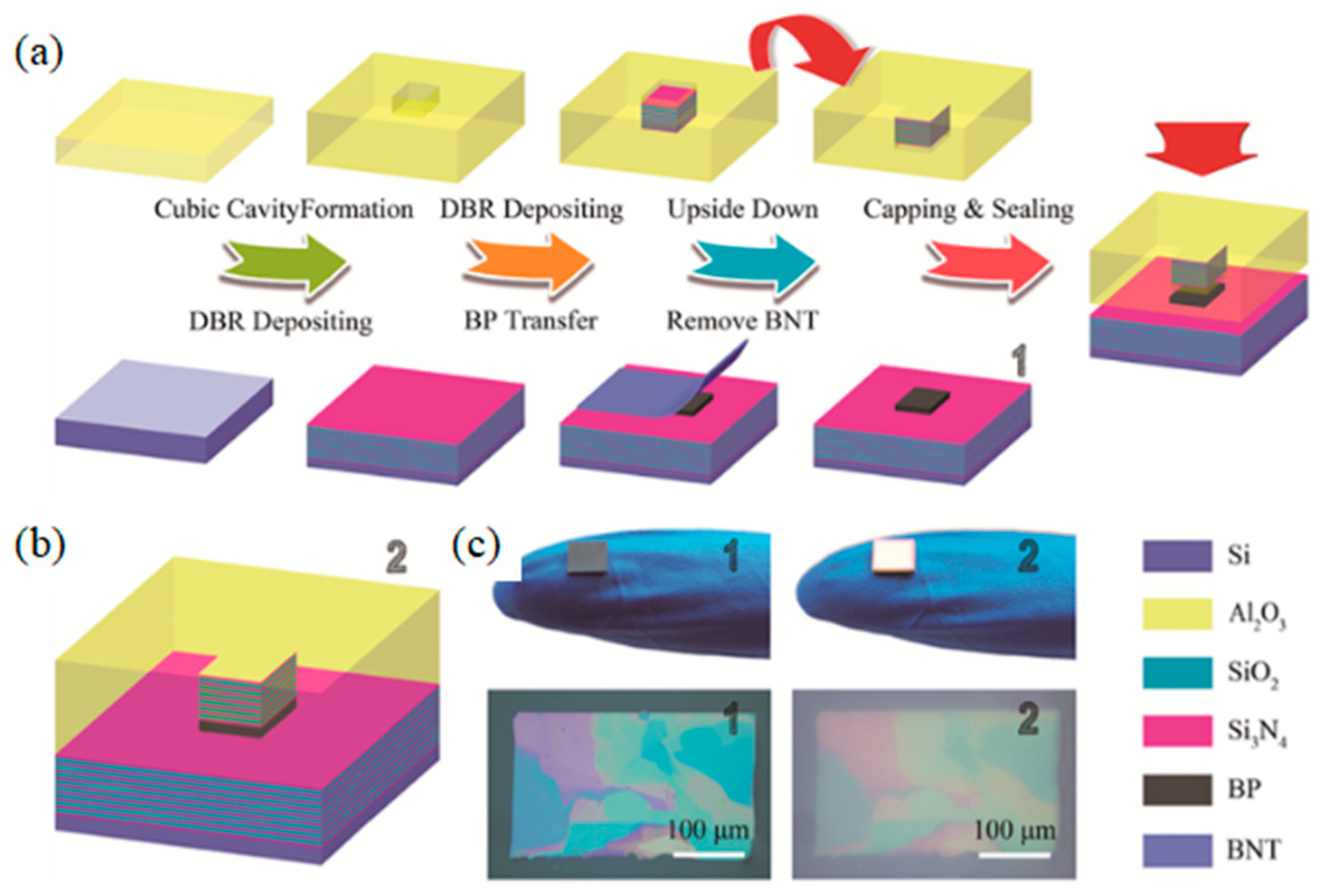
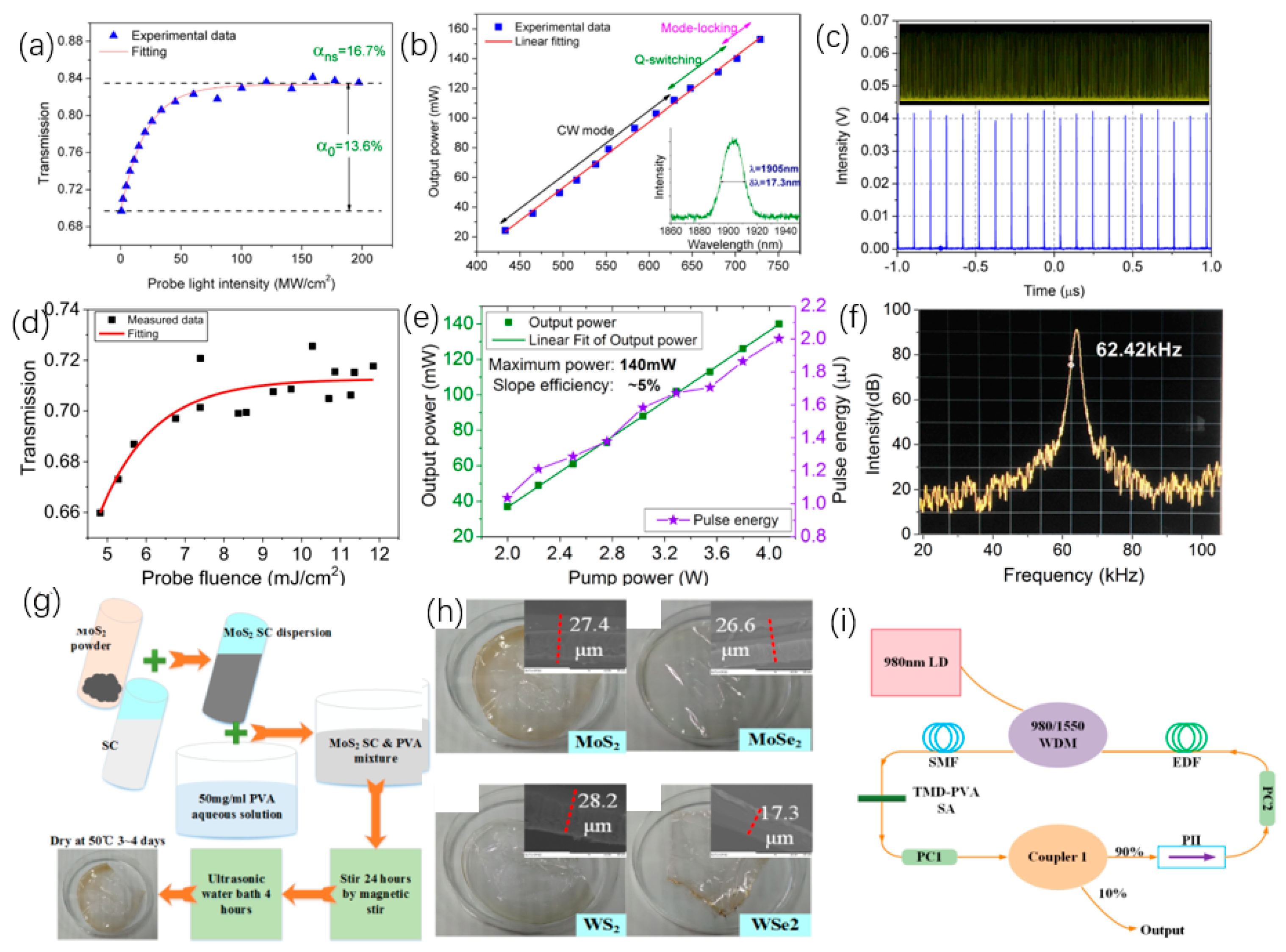
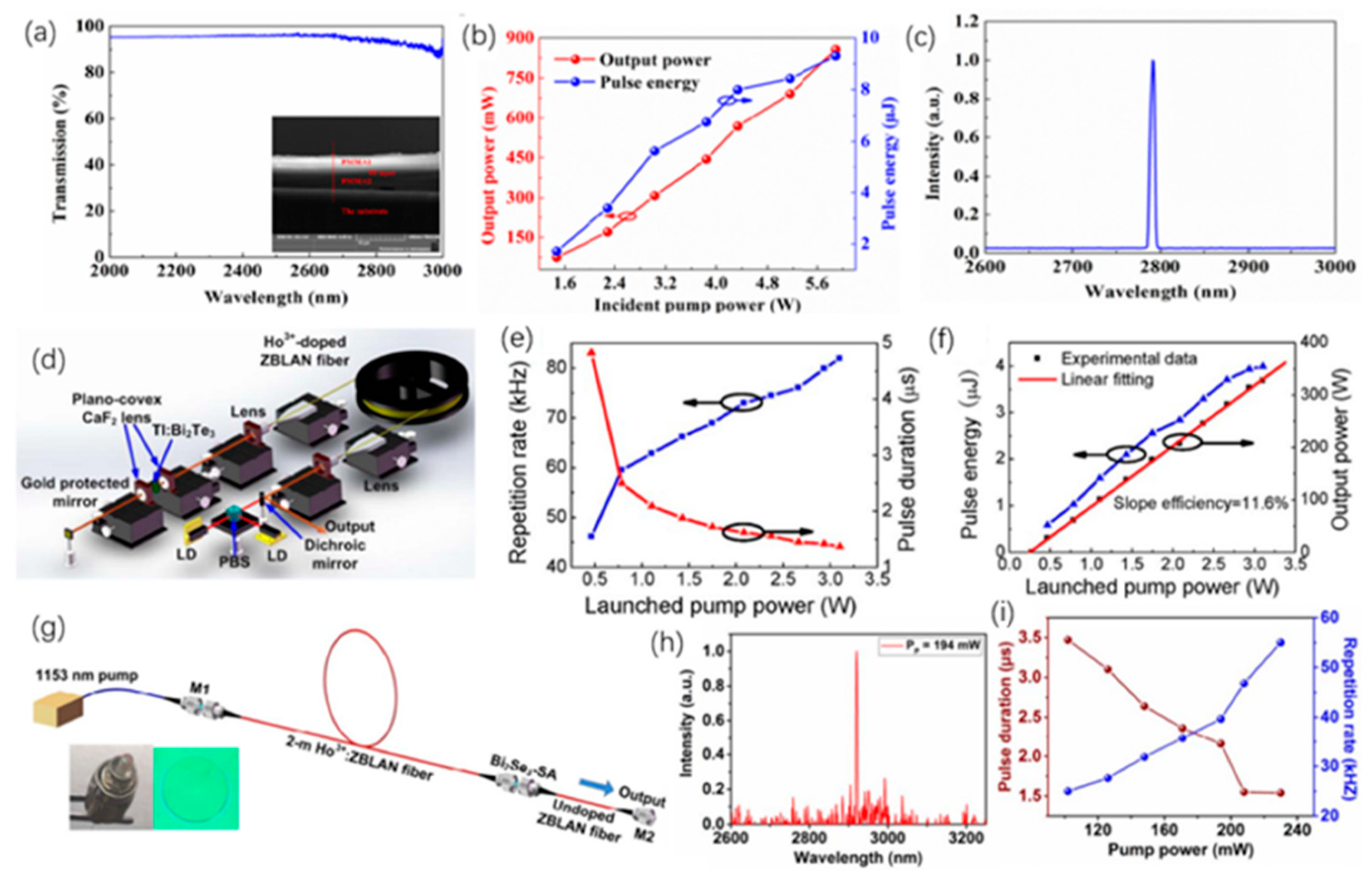
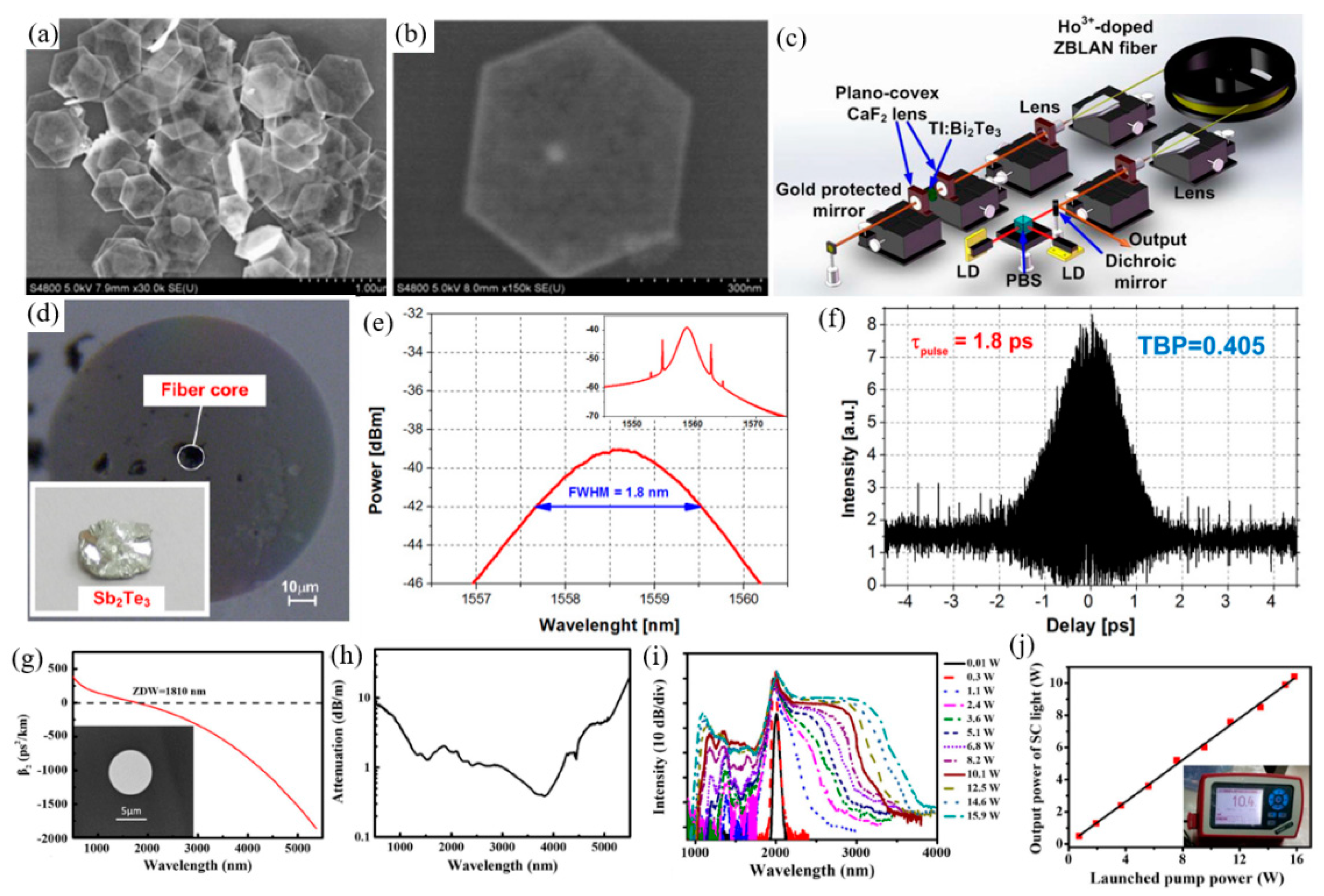

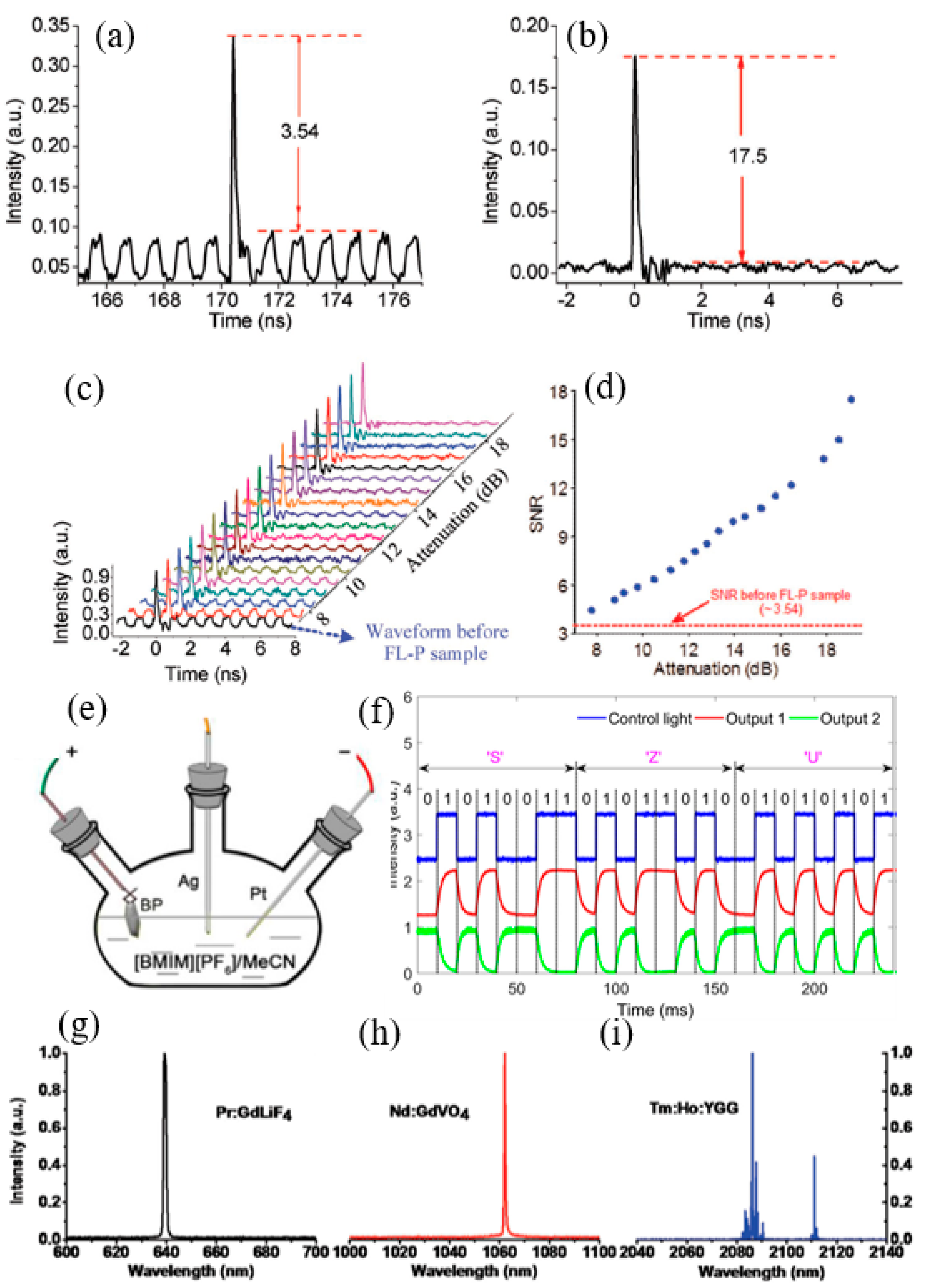
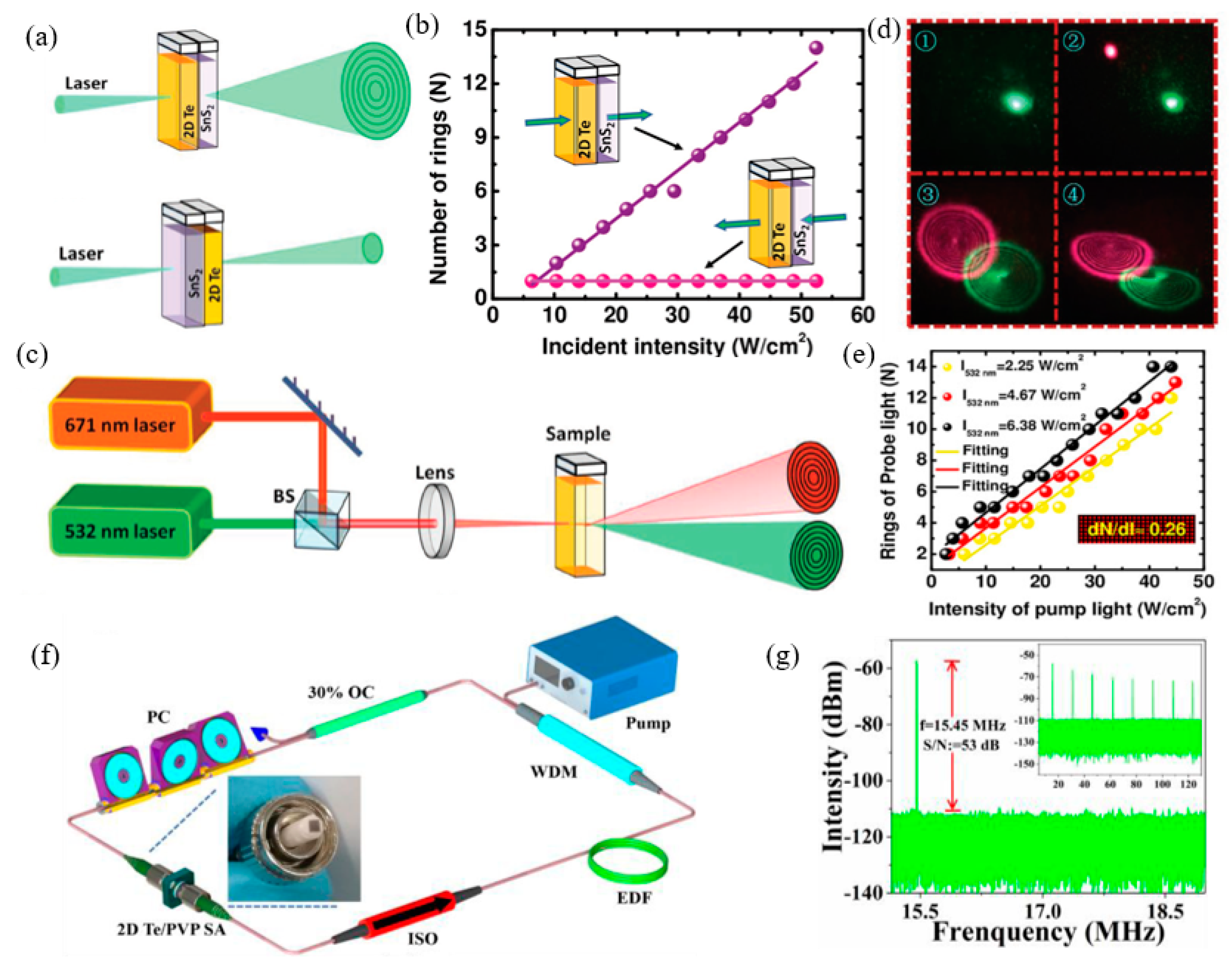
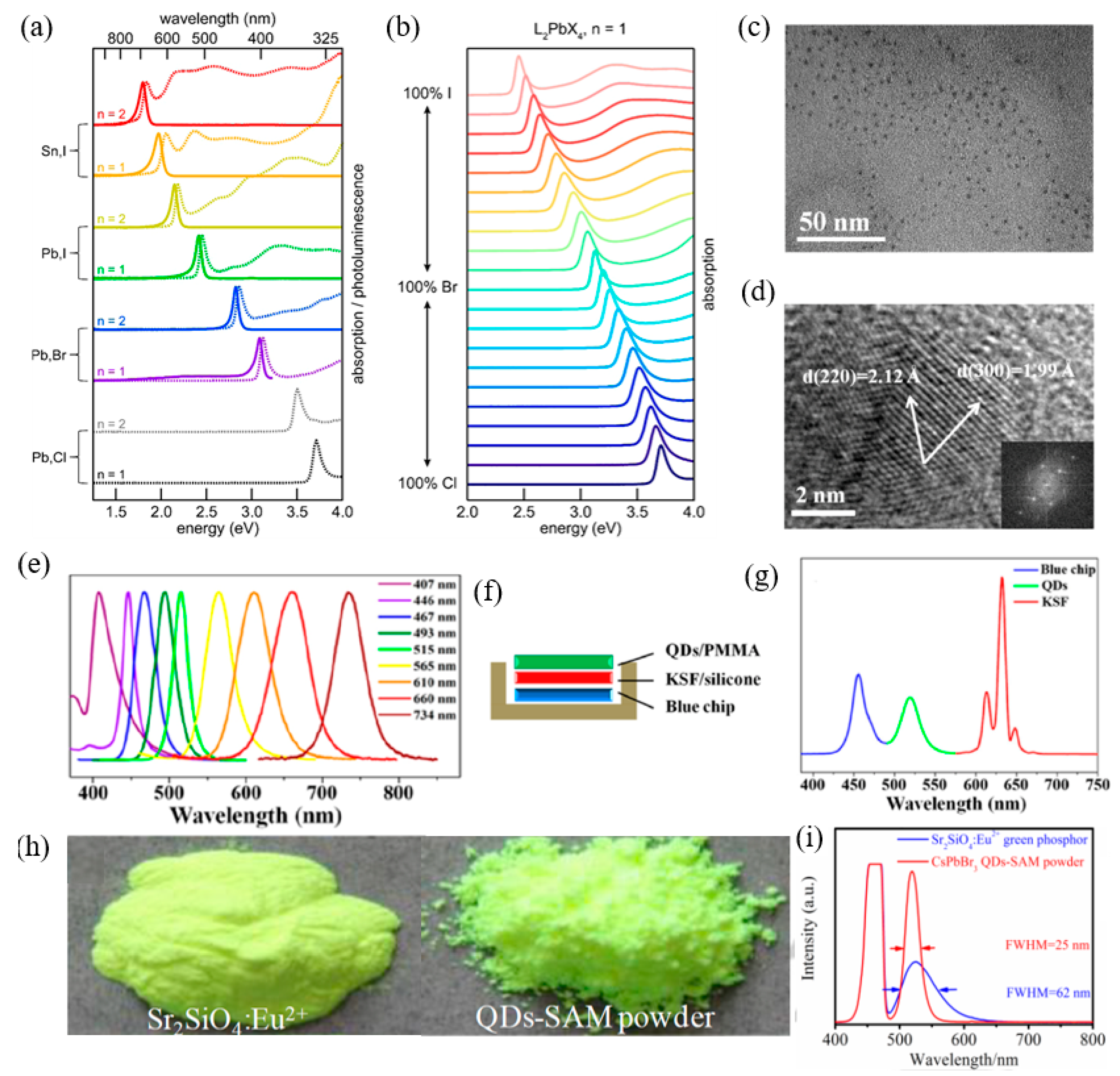

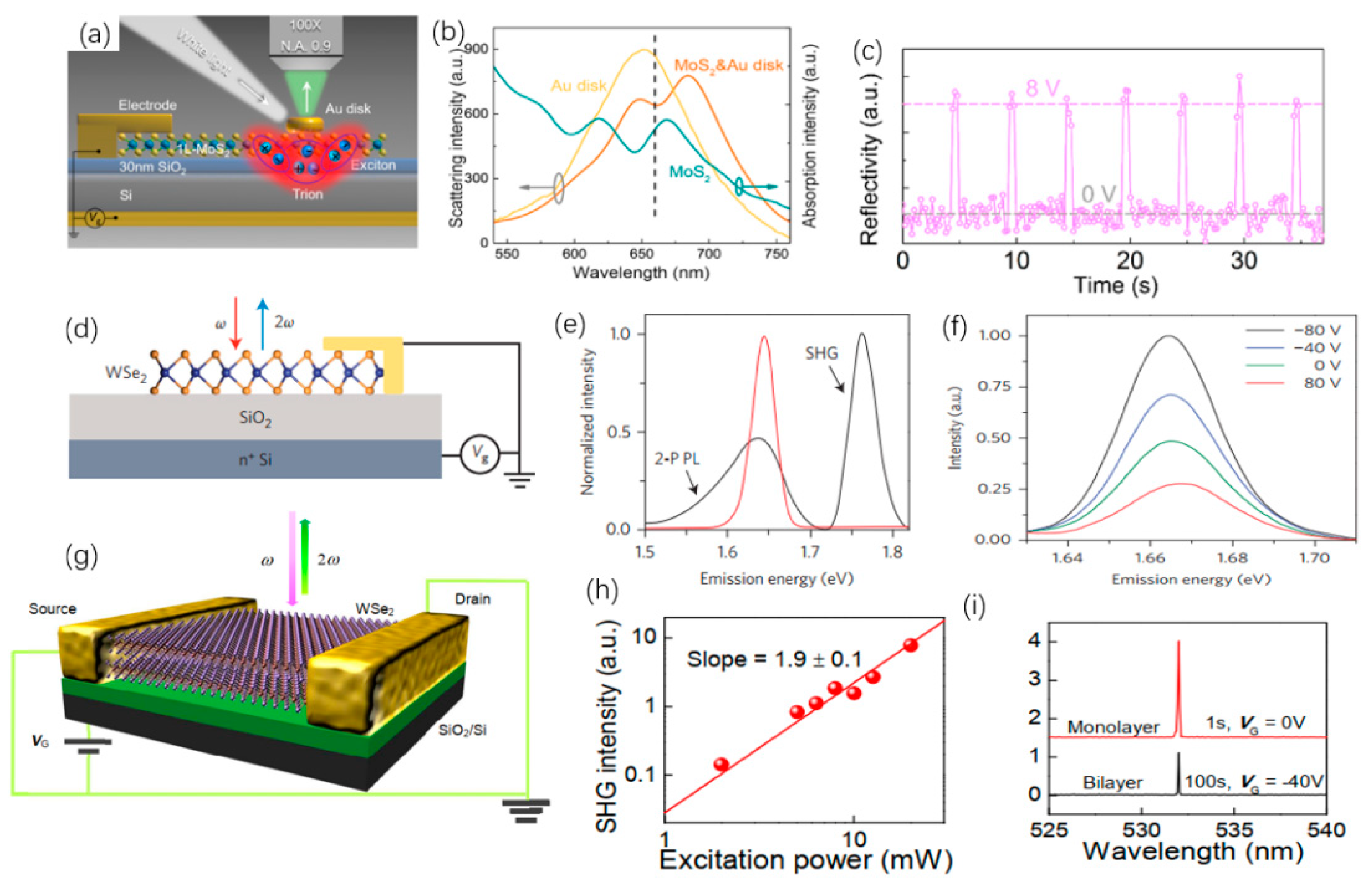
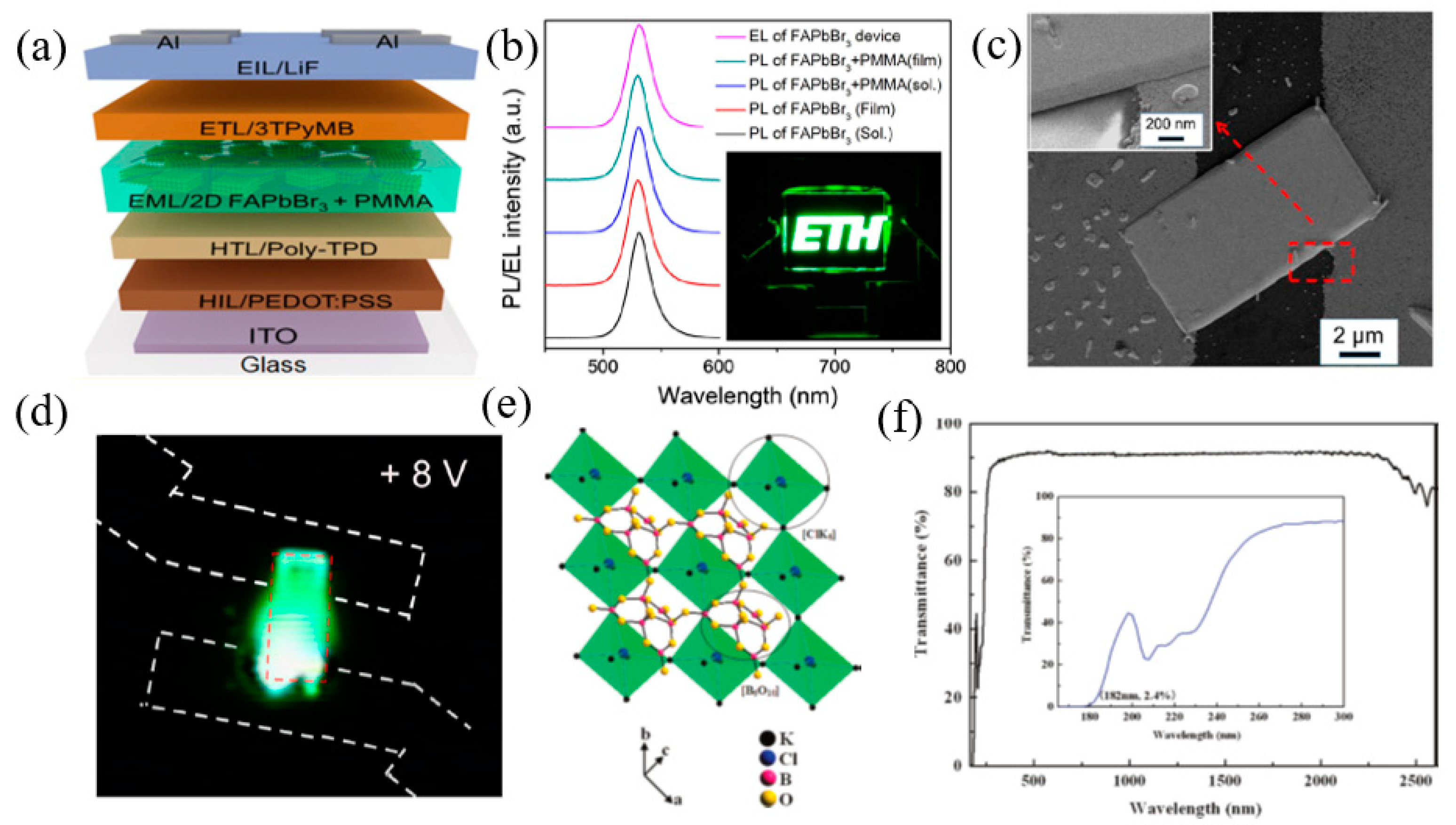
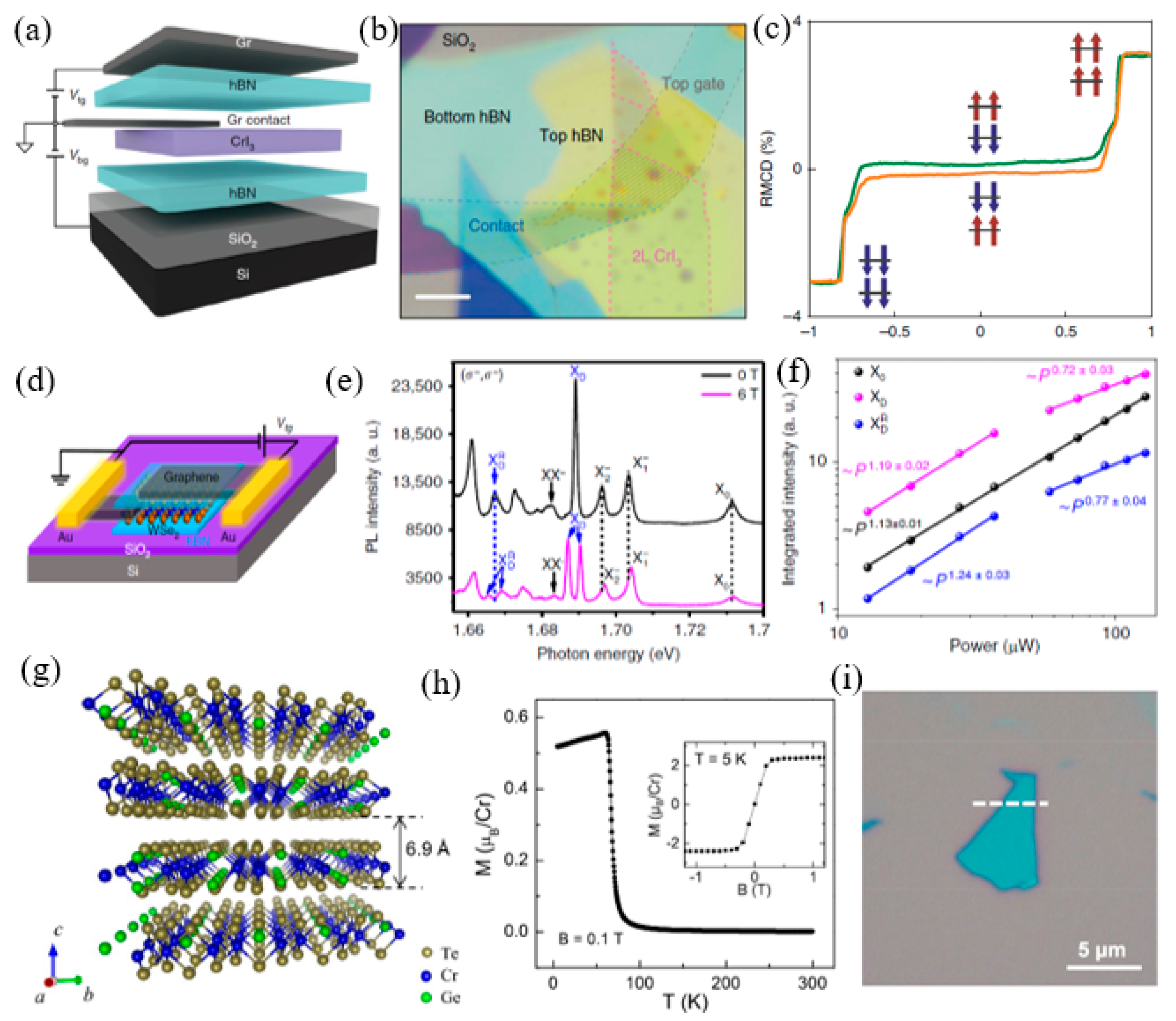
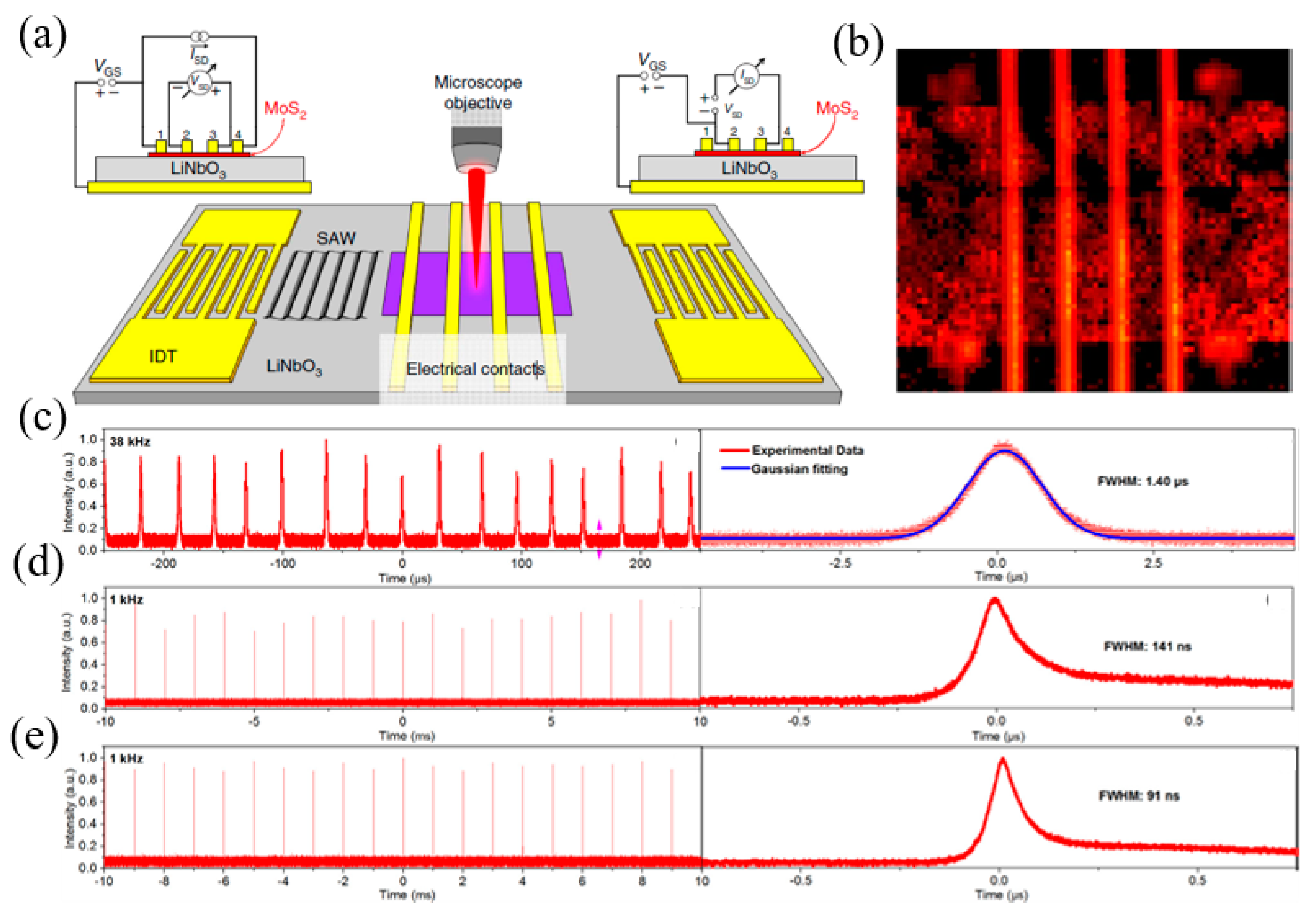
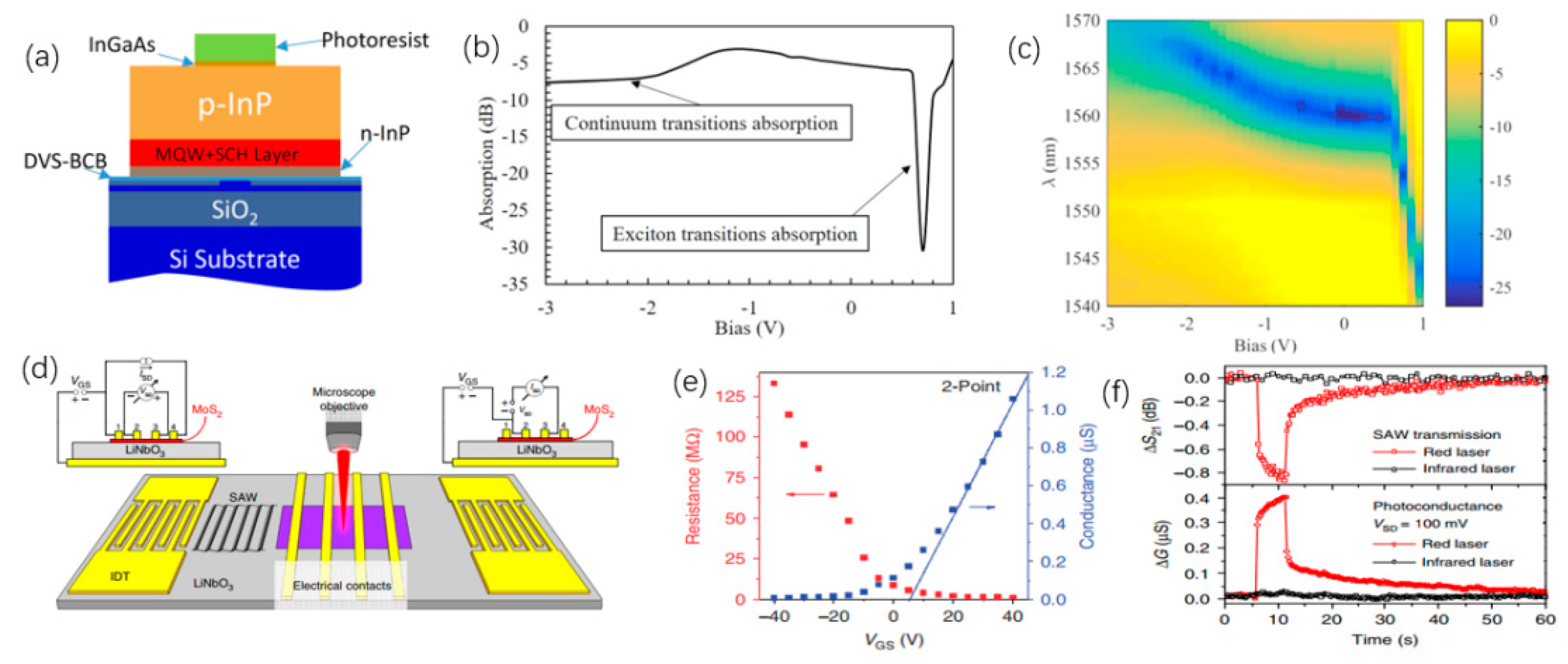
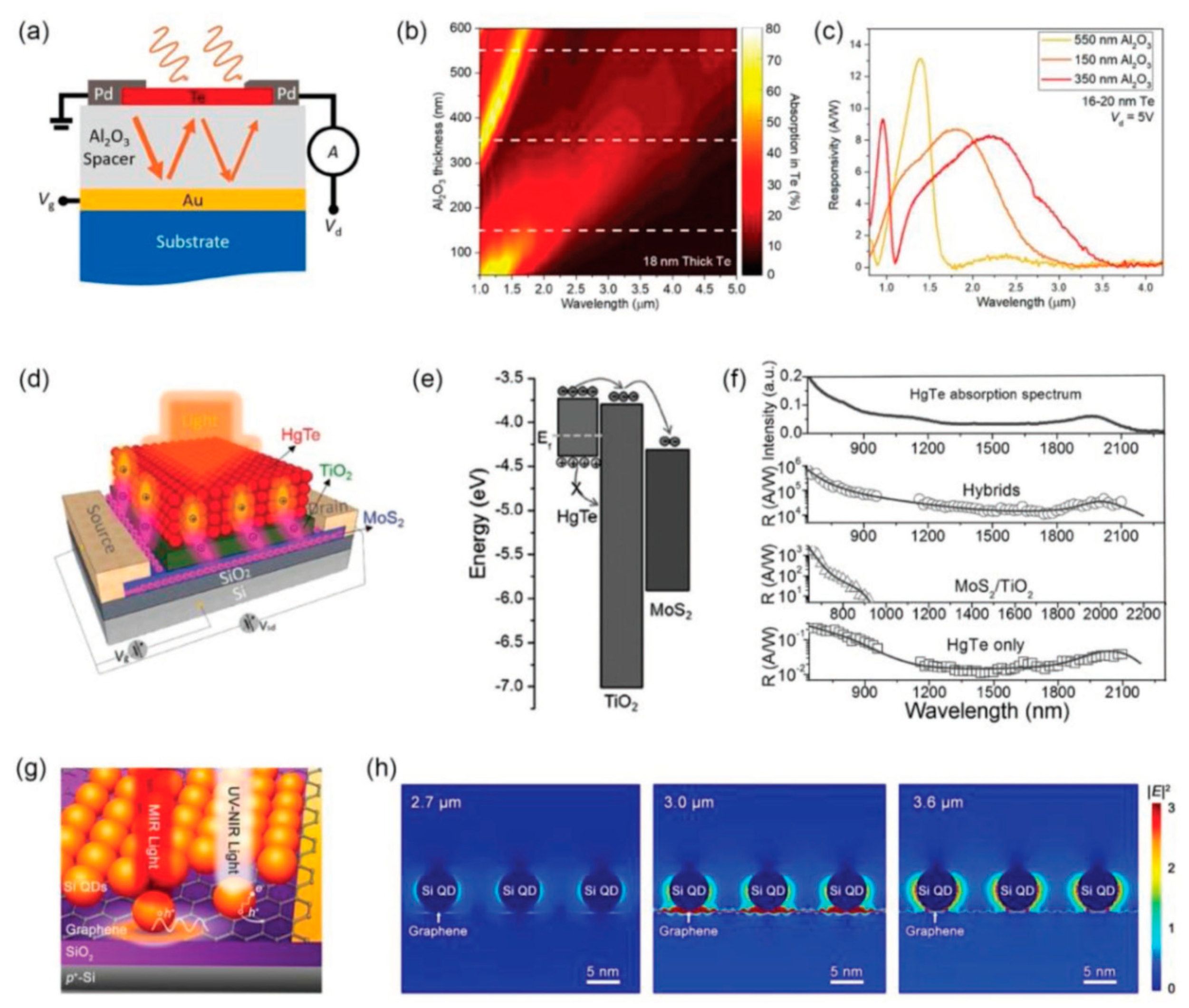
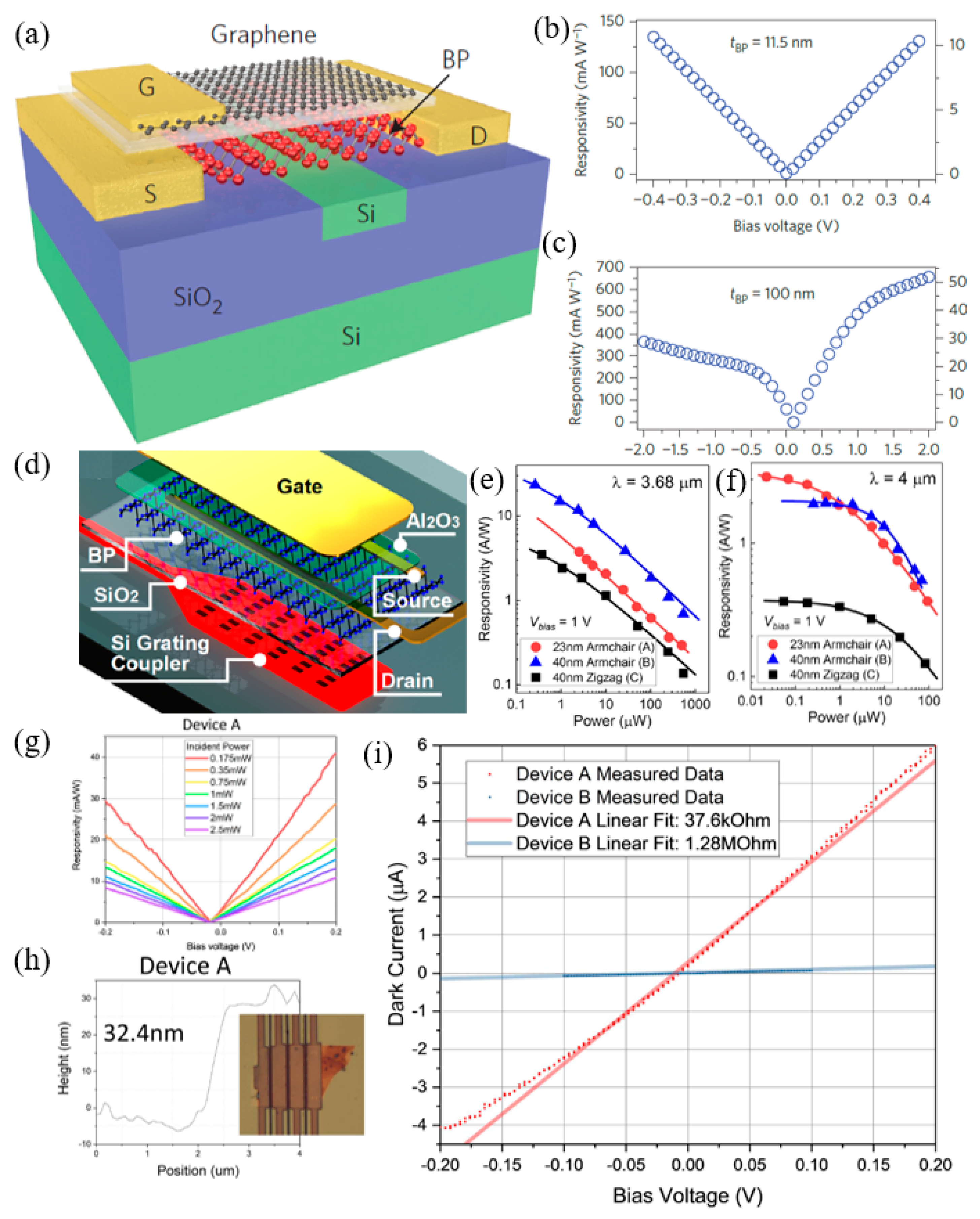
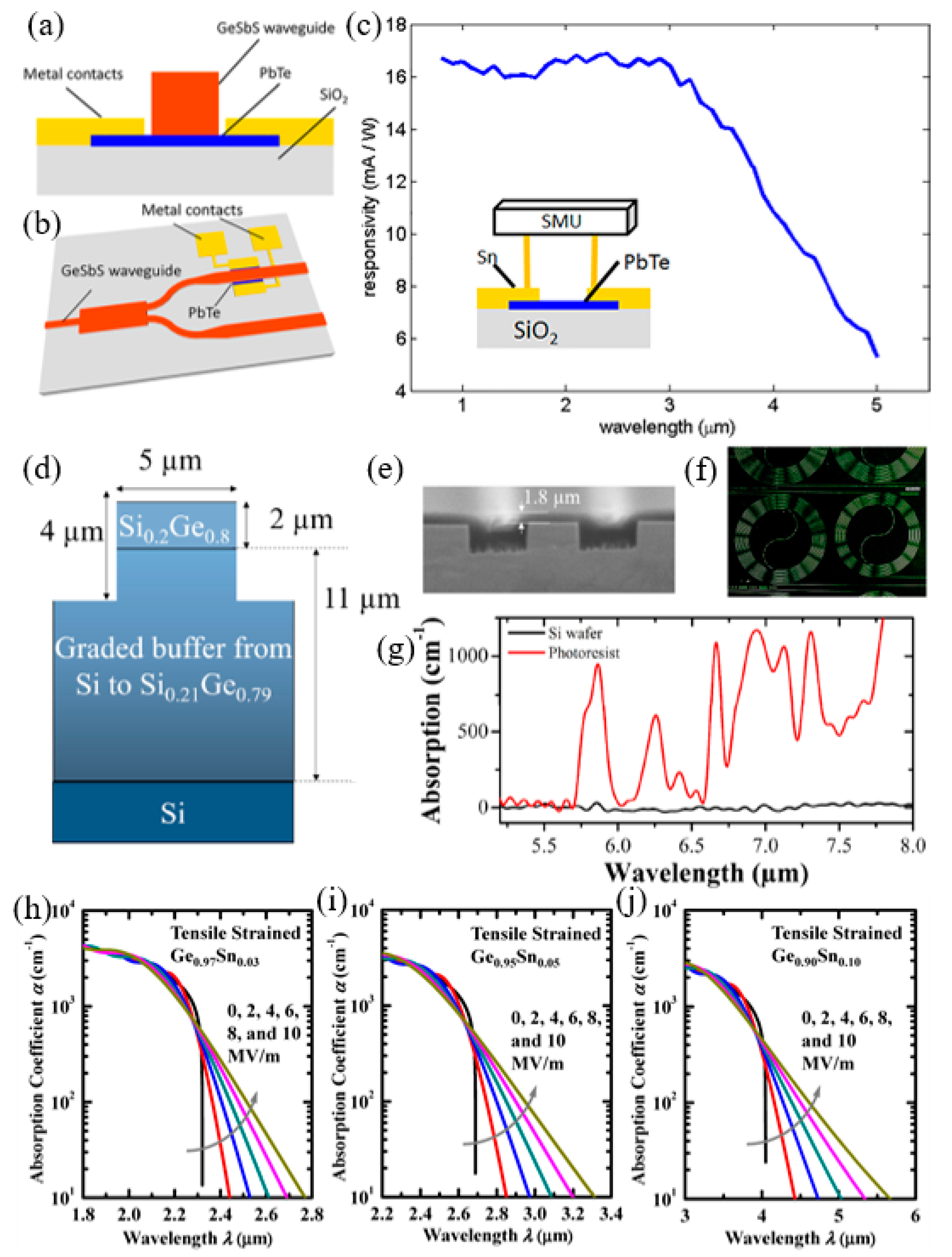

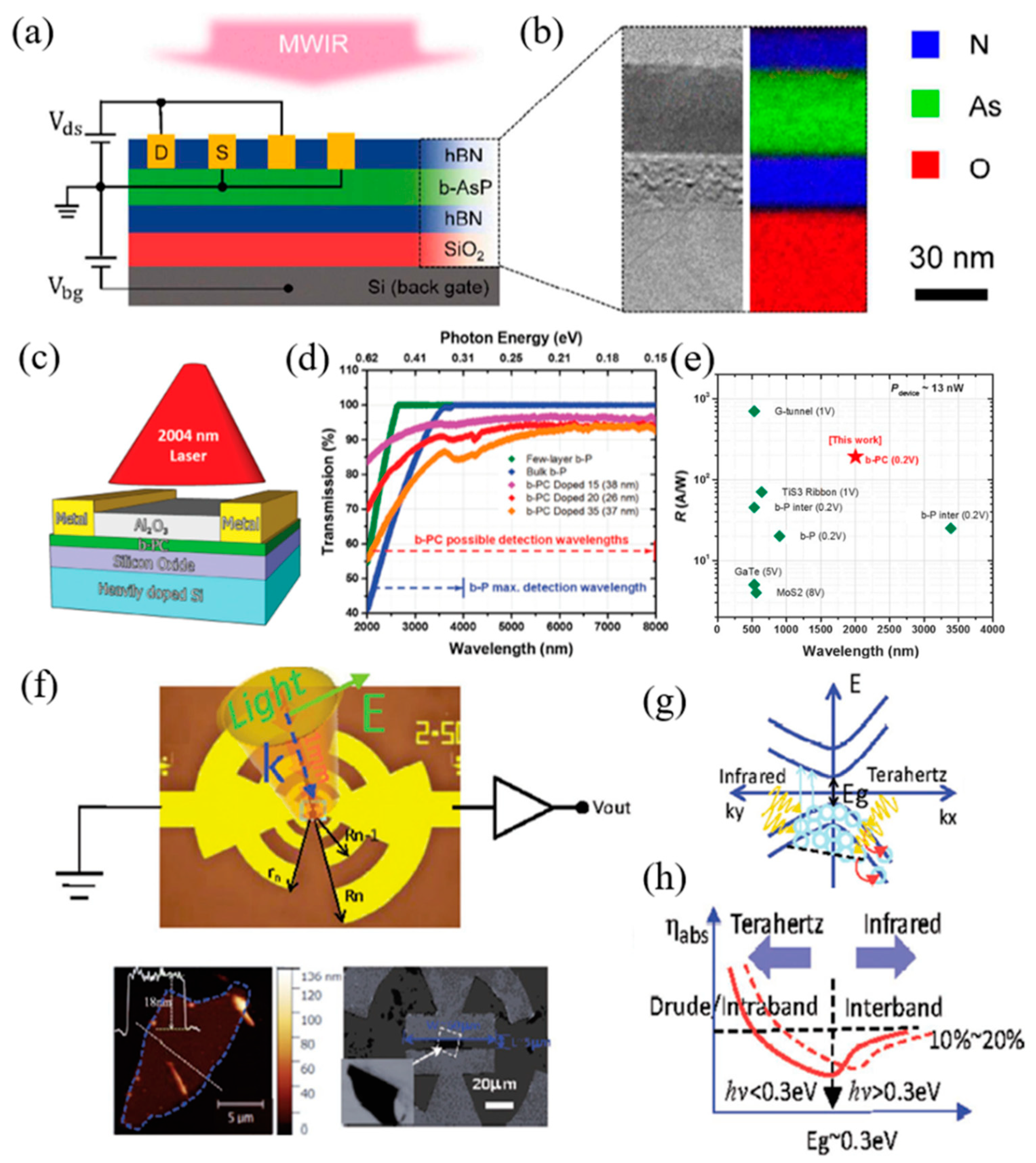


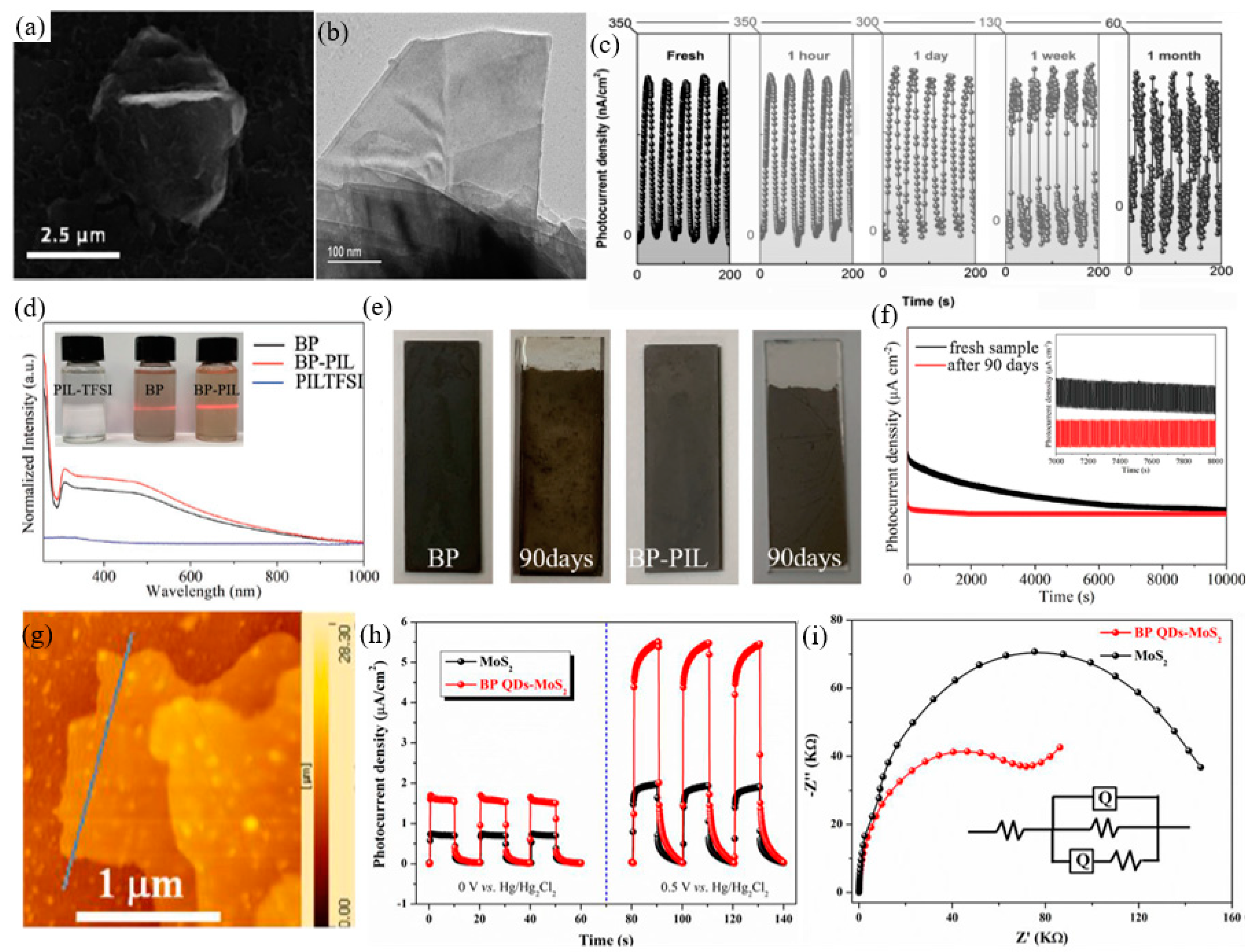
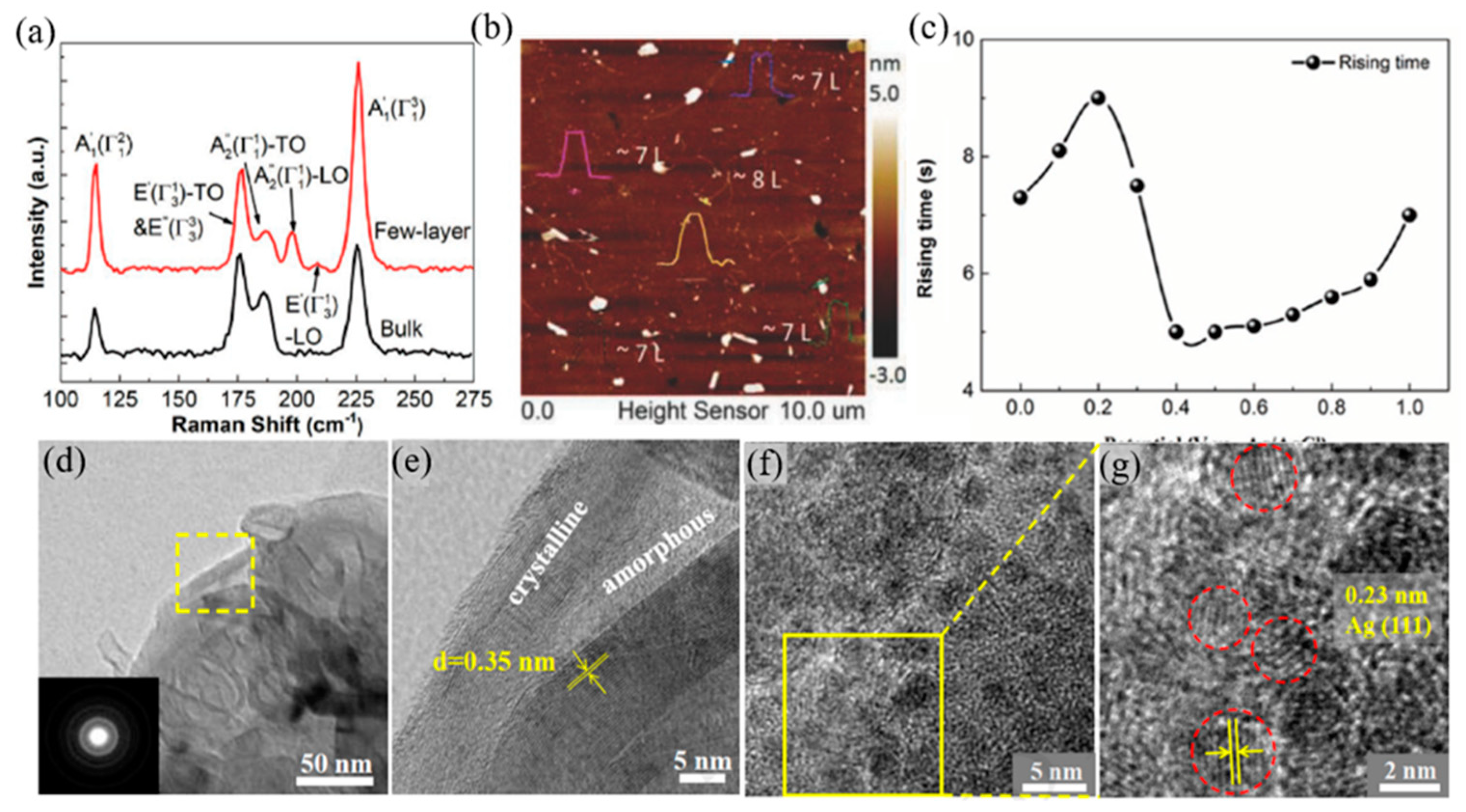
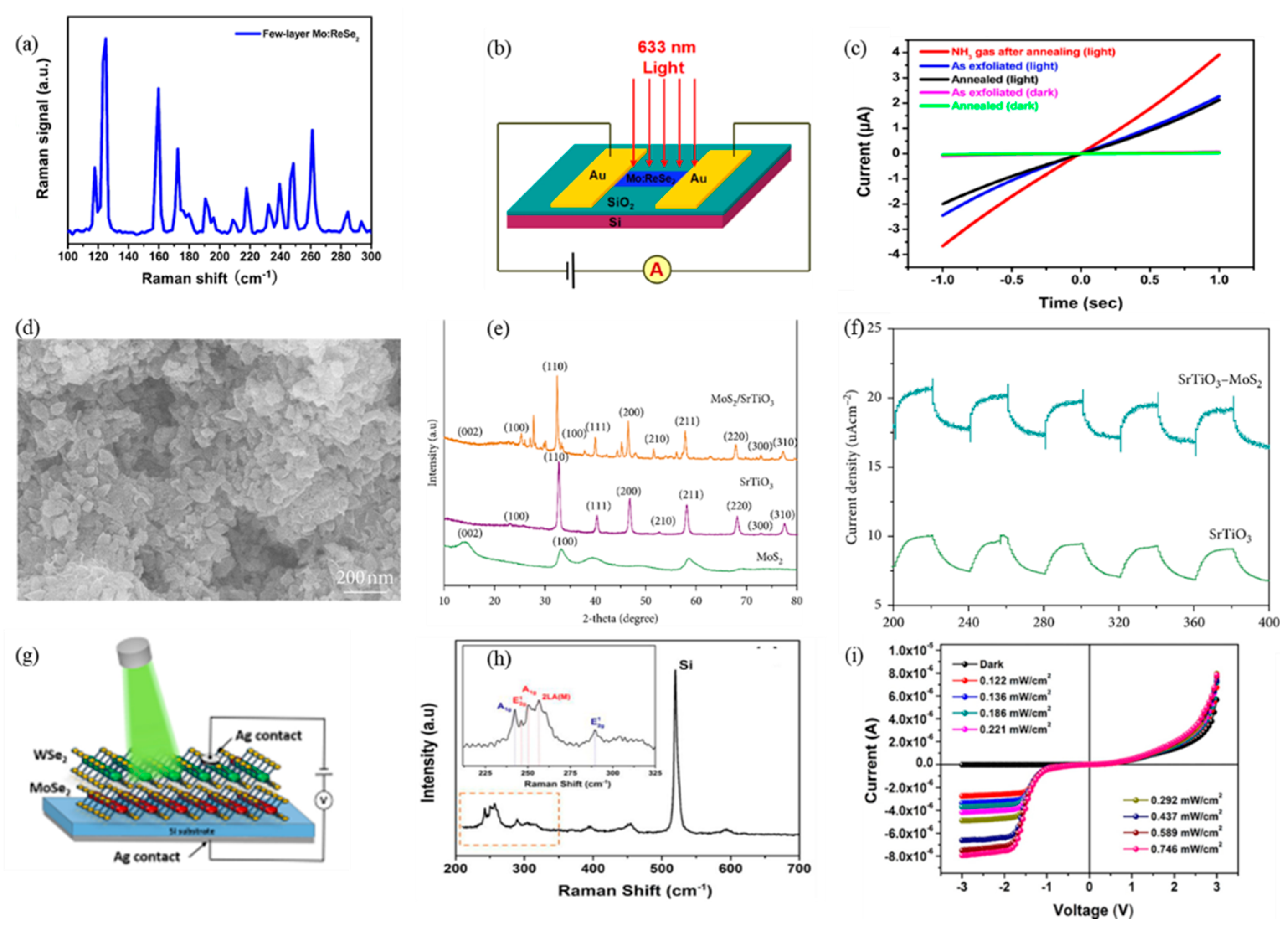
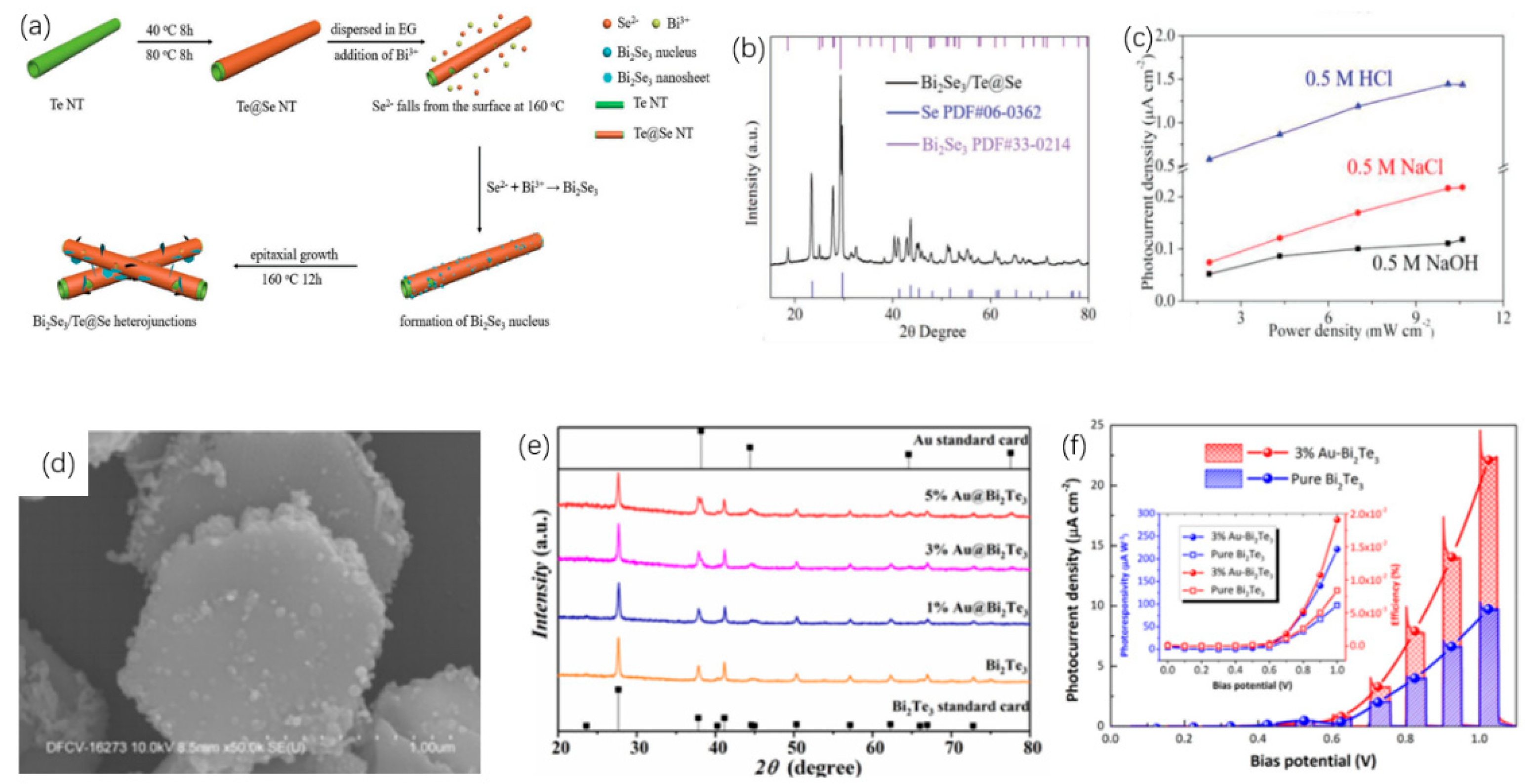

| 2D Materials | Bandgap (eV) | Wavelength (μm) | Luminous Mode | Ref. |
|---|---|---|---|---|
| BP | 0.3~1.5 | 0.83~4.13 | photoluminescence | [185] |
| 2D Ruddlesden–Popper perovskites | 1.53 | 0.81 | photoluminescence | [198] |
| GDY | 0.46~1.10 | 1.12~2.69 | photoluminescence | [141] |
| Er-doped MoS2 | 0.8 | 1.55 | electroluminescence | [190] |
| WSe2 | 1.0~2.4 | 0.51~1.24 | electroluminescence | [201] |
| 2D Materials | Wavelength (μm) | Pulse Duration | Threshold | Frequency | Ref. |
|---|---|---|---|---|---|
| BP | 2.97~3 | CW | 302.6 mW | 12.43 KHz | [205] |
| BP | 3~5 | 42 ps | 613 mW | 24 MHz | [212] |
| Bi2Te3 deposited on CaF2 | 2.979 | 1.37 μs | 3.39 μJ | 81.96 KHz | [210] |
| MoS2 | 2.8 | ND | 430 mW | 62.42 KHz | [213] |
| Bi2Te3 | 2.8~3.0 | ND | 3.0~3.5 W | ND | [210] |
| Bi2Se3 | 3.0 | 1.5μs | 48 mW | 55.1 KHz | [216] |
| 2D Materials | Spectral Range (μm) | Room Temperature Responsivity | On/Off Ratio | Specific Detectivity (Jones) | Ref. |
|---|---|---|---|---|---|
| Few-layer Te | 1.4~3.5 | 13 and 8 A W−1 at 1400 and 2400 nm | 105 | 2 × 109 at 1700 nm | [156] |
| b-As0.83P0.17 | 2.4~8.05 | 15~30 A W−1 | ND | 108 | [331] |
| BN/Multilayer b-As0.83P0.17/BN | 3.4 ~7.7 | 1.2 mA W−1 at 7700 nm | 110 | ND | [100] |
| PdSe2 | 0.45~10.6 | 42.1 A W−1 at 10600 nm | ND | 0.28 | [119,126] |
Publisher’s Note: MDPI stays neutral with regard to jurisdictional claims in published maps and institutional affiliations. |
© 2022 by the authors. Licensee MDPI, Basel, Switzerland. This article is an open access article distributed under the terms and conditions of the Creative Commons Attribution (CC BY) license (https://creativecommons.org/licenses/by/4.0/).
Share and Cite
Cao, R.; Fan, S.; Yin, P.; Ma, C.; Zeng, Y.; Wang, H.; Khan, K.; Wageh, S.; Al-Ghamd, A.A.; Tareen, A.K.; et al. Mid-Infrared Optoelectronic Devices Based on Two-Dimensional Materials beyond Graphene: Status and Trends. Nanomaterials 2022, 12, 2260. https://doi.org/10.3390/nano12132260
Cao R, Fan S, Yin P, Ma C, Zeng Y, Wang H, Khan K, Wageh S, Al-Ghamd AA, Tareen AK, et al. Mid-Infrared Optoelectronic Devices Based on Two-Dimensional Materials beyond Graphene: Status and Trends. Nanomaterials. 2022; 12(13):2260. https://doi.org/10.3390/nano12132260
Chicago/Turabian StyleCao, Rui, Sidi Fan, Peng Yin, Chunyang Ma, Yonghong Zeng, Huide Wang, Karim Khan, Swelm Wageh, Ahmed A. Al-Ghamd, Ayesha Khan Tareen, and et al. 2022. "Mid-Infrared Optoelectronic Devices Based on Two-Dimensional Materials beyond Graphene: Status and Trends" Nanomaterials 12, no. 13: 2260. https://doi.org/10.3390/nano12132260







